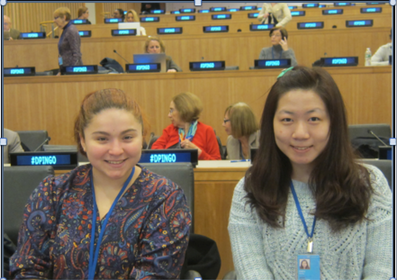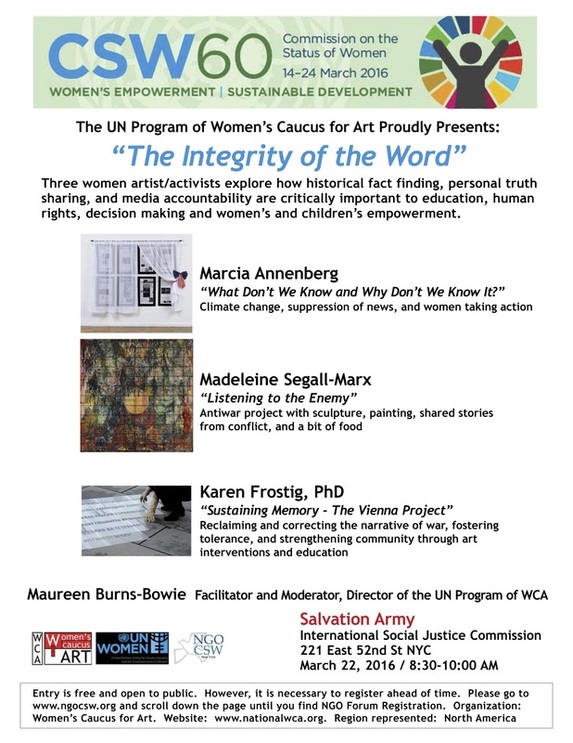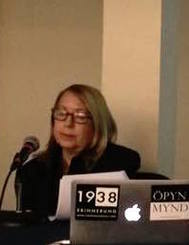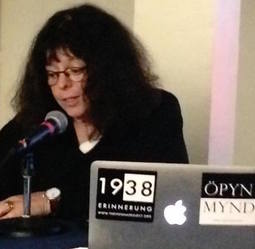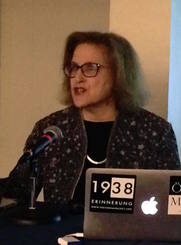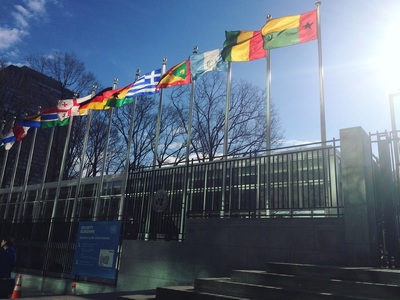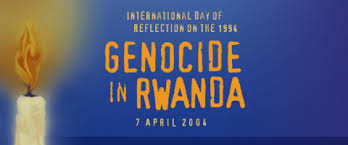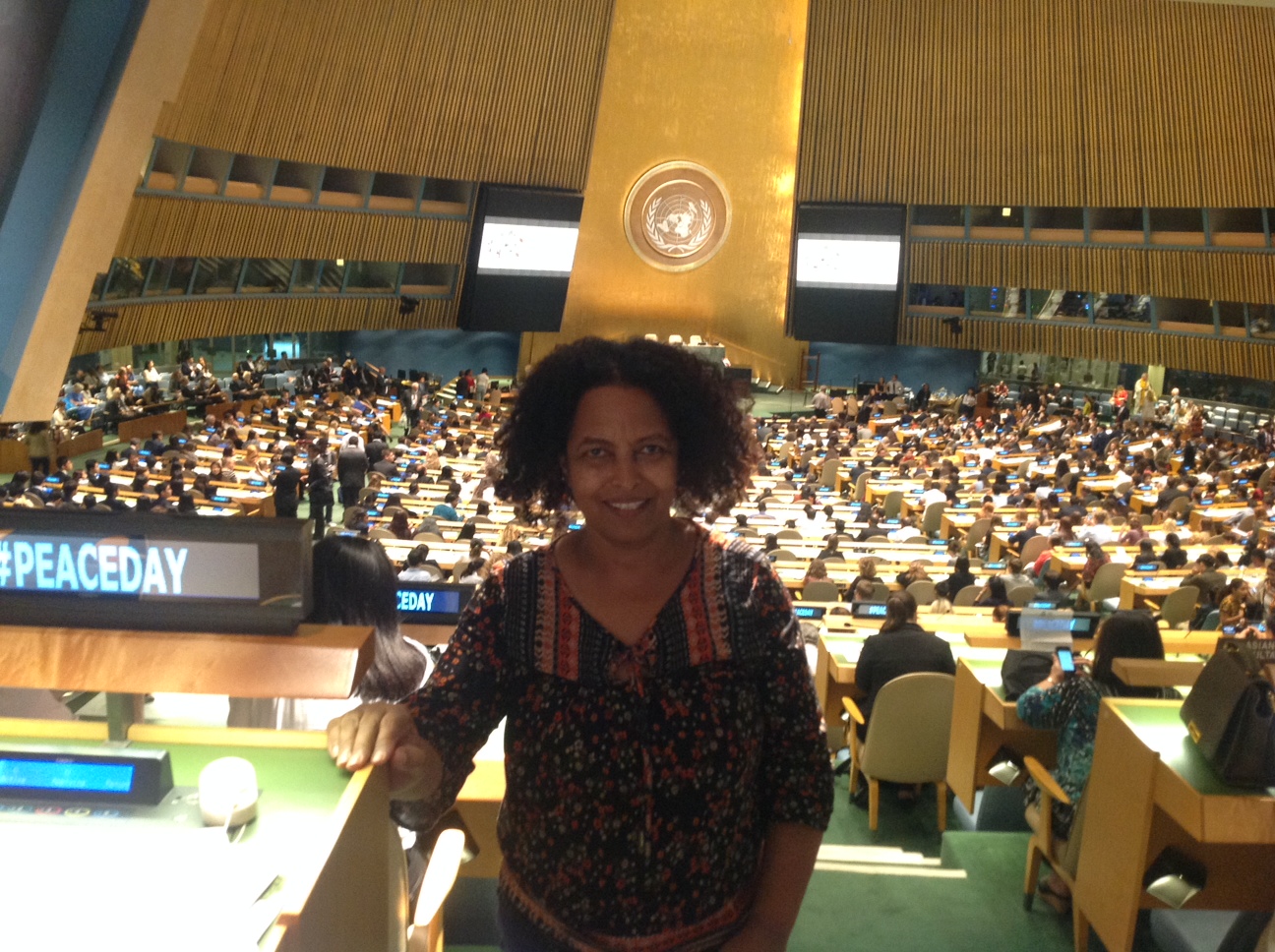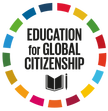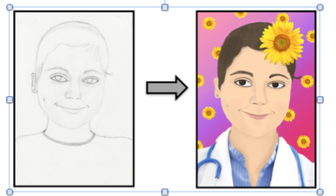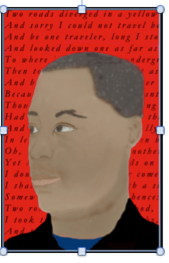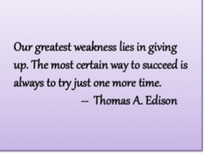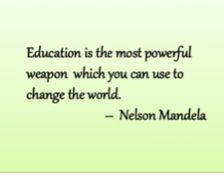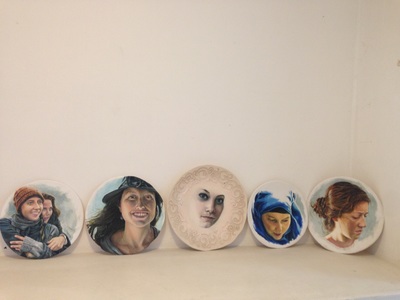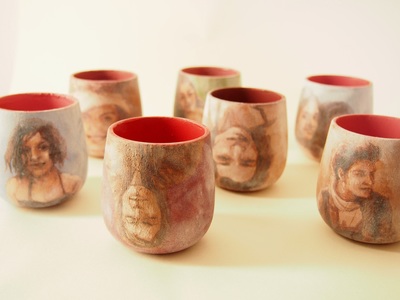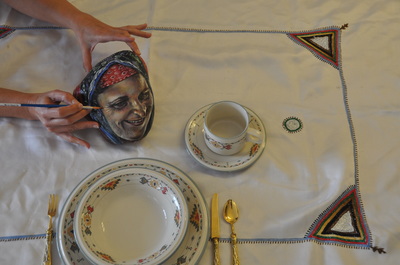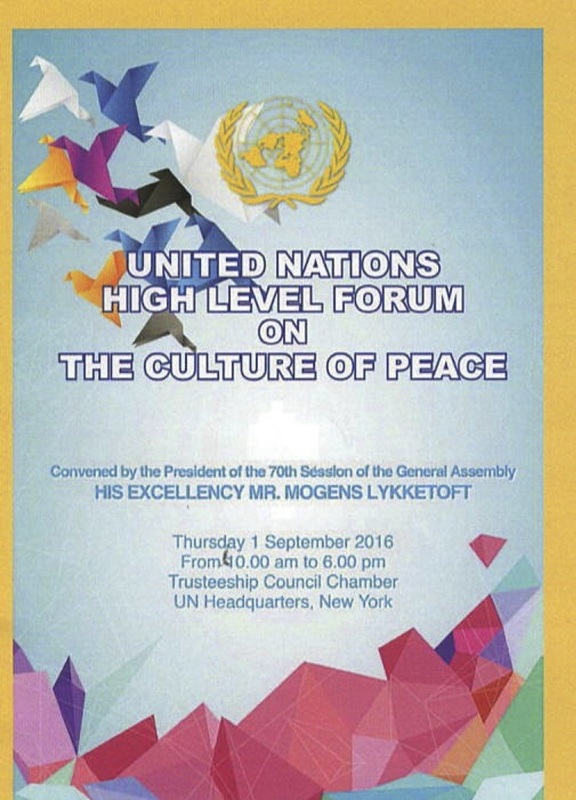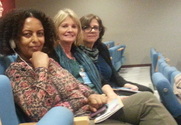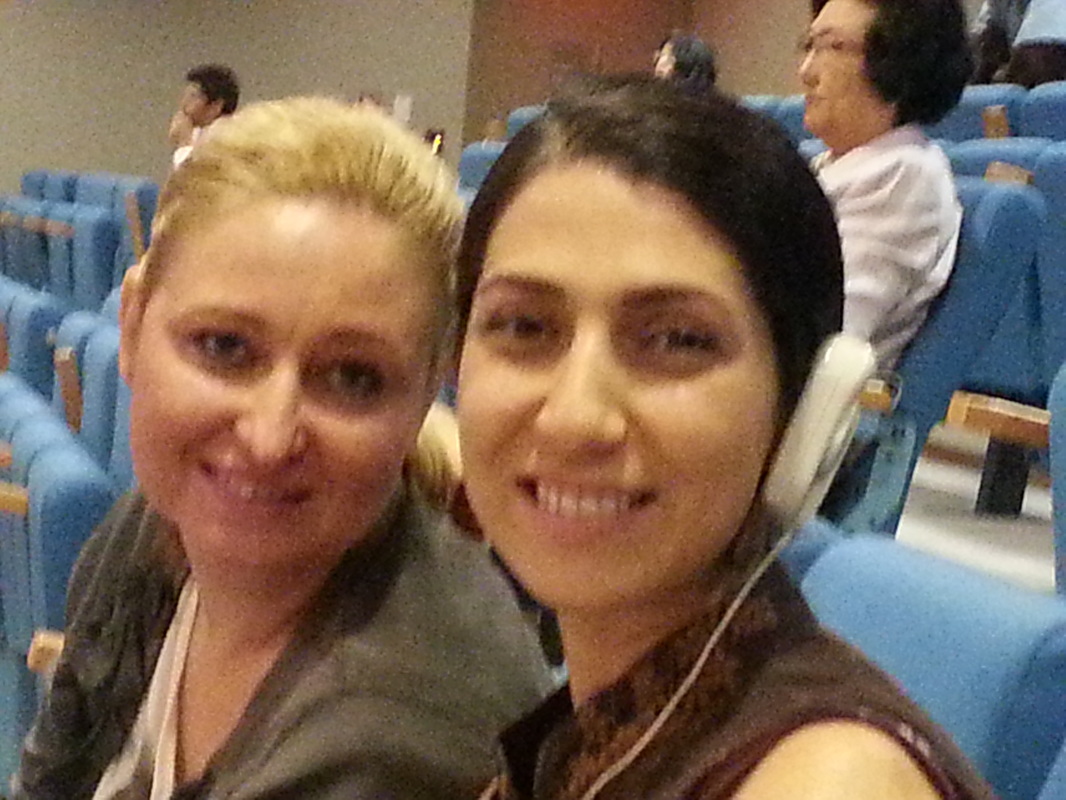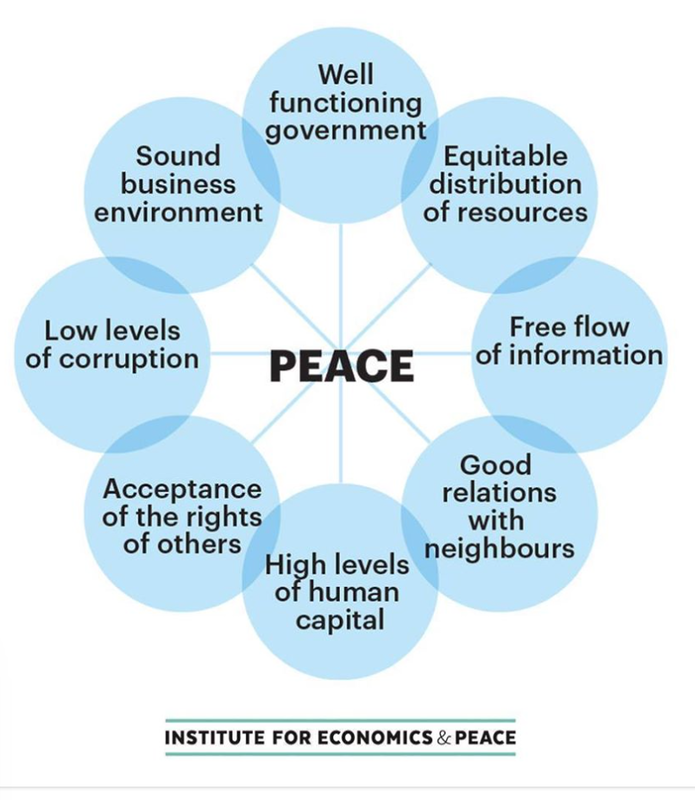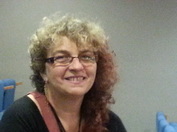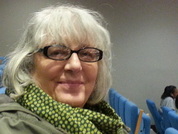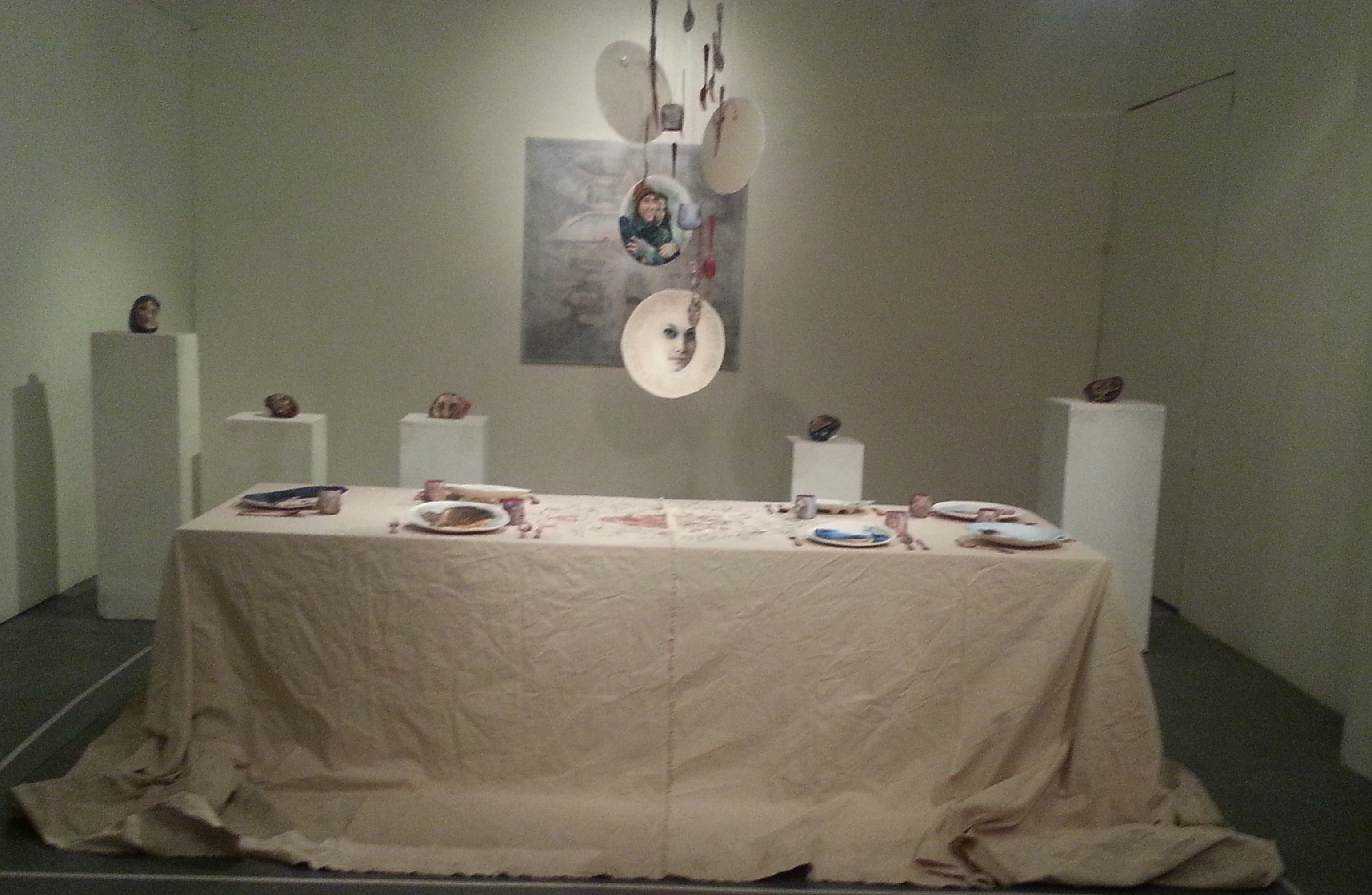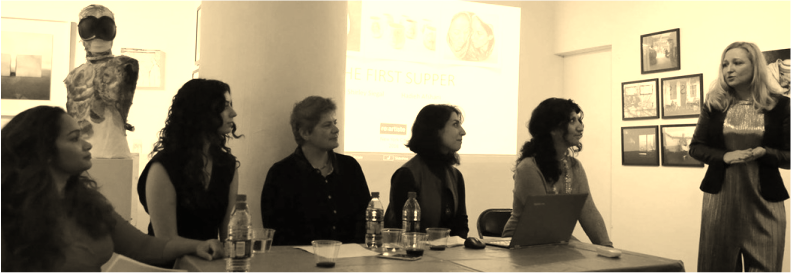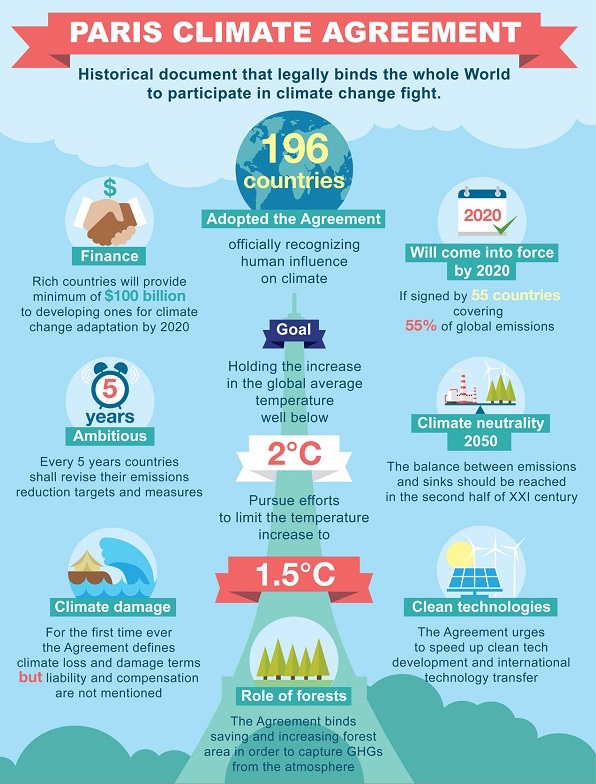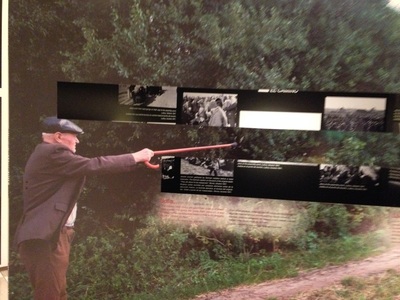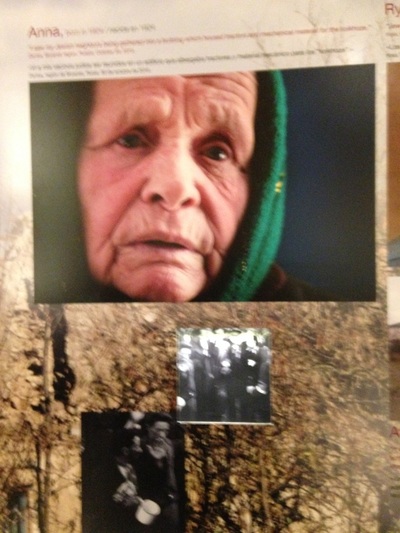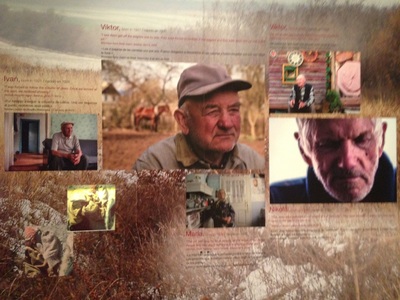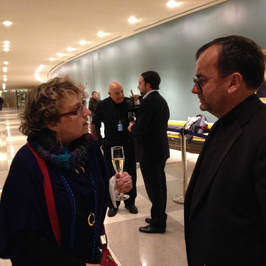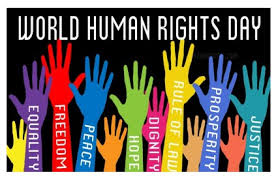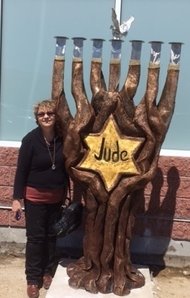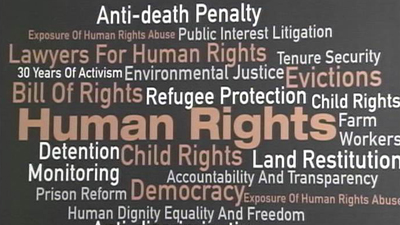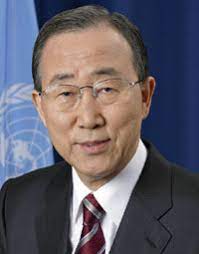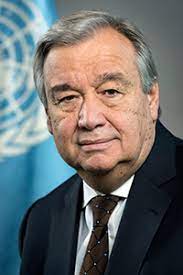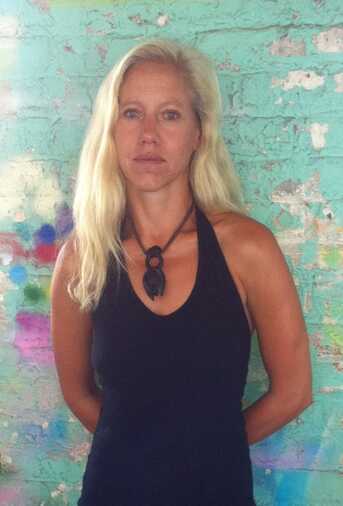UN Program Director News and Updates 2016
____________________________________________________________________________
UPDATE # 1
Melissa Martinez
Growing up, I thought quite frequently about what an inconvenience it was that I was born a female. It’s actually something that I still think about from time to time. Life just seemed better for boys when I was younger. I also often felt that men in my family were treated with more respect than the women, but I always felt that the women deserved to be treated better because, honestly, the women in my family were the hardest workers. While I was in school, I always achieved the highest grades, worked incredibly hard to save money, and strived to find what exactly I was meant to do with my life; but my male cousin, who did average and lacked passion always received the best treatment. This doesn’t make me hate my cousin at all because it isn’t his fault that our elders were raised to value their male sons over their female daughters. It was extremely difficult growing up in my household because my opinions weren’t valued and I became just another nagging female that brought everyone down just for expressing my feelings. I could say one fact or observation and if any of my male family members said the same thing they would acknowledge it. Imagine always being in a state of “Hey! I’m here too!” and you would feel the same exact way that I feel when I interact with my family. I wouldn’t even be grazing the tip of the iceberg if I spoke about the disrespect and outright dirty treatment that I, and millions of women, get in this everyday life. It’s an absolute tragedy that women can’t feel safe leaving their homes everyday. I don’t even feel comfortable leaving my home and I have lived in my neighborhood my entire life. I’m extremely aware that mistreatment happens to both sexes; the difference is that more mistreatment happens to women and most of it goes unnoticed because it’s “just something that happens.” I think that women work incredibly hard to be on the same tier as men and the way men are treated. We all just work hard so that one day we can say that men and women are treated equal and that we helped contribute to that change. I’m so thankful for movements that came about while I was a teenager that helped me feel comfortable being a woman. Speeches given by Emma Watson and Malala Yousafzai helped me to feel proud of who I am, but also helped me to realize that help was necessary outside of my frame of reference. I feel more empowered to be a woman today than I felt years ago. Feminism by definition is the belief that men and women should be treated equal. I am a feminist and I feel more motivated today to assist in the feminist movements that are still struggling to take flight. All women deserve to be treated with respect as individuals, not just women, because if we earned that respect, then we shouldn’t have to be singled out by our genders either. I believe that I would be a good candidate for this internship because I am a strong believer that art and ideas are an amazing way to help bring the sexes together. Especially today, this artistically evolved generation has come about and more people, more men, have grown to appreciate art’s greater meanings. As an artist, I understand firsthand how hard it is to get people to understand the message you’re portraying in your pieces and how hard it is to capture their attention without flashy, modern looks. It’s my wish that with the experience I’d get from this internship, I’d be able to work with other individuals and assist in the feminist movements that so many women are trying to bring forward. As a woman, I can empathize and place myself into the shoes of those I want to help. I know that my personal family sexism issues are not only my own and I want to help inspire young women like myself to keep being that “nagging female” in their family because their points are valid and just. Every woman should feel like they matter not only in society, but also in the comfort of their homes. To be a part of this group would mean that I have an active role in how this change is brought forward. We’re not only working on a change in society, but also a change within ourselves as women. |
Shirley Chen Pursuing a life as an artist will never be complete if one does not combine studio work with real-life experience; therefore, I would like to apply for this internship to be a UN Youth Representative for the Women`s Caucus for Art. I know the United Nations to be a place where everyone gets involved in making the world a better place, promoting peace, global security, development, and environment sustainability, and I would like to learn more about women in the arts who are concerned with these issues and to gain more insight into the professional world of being an artist through WCA. For example, I am interested in learning more about current issues such as gender inequality and the lives of women not only in the United States, but also all over the world. I am interested in issues, such as the Holocaust, genocide, and famine, and contributing to the awareness of women’s art and wellbeing. I want to participate in groups with committed people at the United Nations to gain experiences such as leadership opportunities and professional development for women in the arts, which could help me to reach my artistic, educational and career goals. I am currently studying Art and Design at Queensborough Community College, and I am planning to transfer to a four-year college in fall 2016. I believe that my last semester before obtaining an AS degree is the right time to apply for an internship that relates to two of my main interests: arts and global issues. The mission of WCA is to promote women's work in art, education and social activism and to help maximize the earning power of women, which are all significant goals. It would be a great opportunity for me to take part with women who are interested in the art field. My strengths as an artist involve creative work in painting, metal crafts and an interest in split-second photography. In addition, I am a self-regulated learner and have good time management skills for planning my schedule and planning for future goals. I am eager to learn by using my teamwork spirit, collaboration and prioritization skills, and I would like to broaden my horizons to include planning projects and art events. WCA is a national organization of women artists and academics, which attracts me greatly because it includes artists from different backgrounds. I look forward to meeting other women to discuss art by women and the role of art. One of my important objectives is to support women's work because we face employment discrimination in the arts and media. Women are creating some excellent artwork all over the world and they should be advocating for equity in the arts for all. I believe it is important to respect all individuals through networking with diverse groups. I believe in being open to the views of others and encouraging others. Women have the right to pursue their dreams, to do positive things in life, and to have faith in themselves. I hope I may be able to do the same with regard to my own work in the future. I am confident that I can be a good candidate for this internship at the United Nations, and I look forward to gaining more knowledge about what is happening around the world in order to help people in a positive way. |
____________________________________________________________________________
UPDATE #2
"The Refugee Crisis: Rethinking and Strengthening the Response"
Liz DiGiorgio
Moderator: Maher Nasser, Director of the Outreach Division of the Department of Public Information,
Panelists: Karen AbuZayd, Special Adviser on the Summit Addressing Large Movements of Refugees and Migrants; Ninette Kelley, Director, New York Liaison Office, UNHCR; Predrag Avramovic, Head of the Humanitarian Section, European Union Delegation to the United Nations in New York; Susana Sottoli, Associate Director, Programme Division, UNICEF; Mr. Barbriel Garang Atem, Deacon, Sudanese Dinka-language Congregation, All Saints Episcopal Church (via Skype); and Neil Grungras, Founder and Executive Director, Organization for Refugee, Asylum and Migration
Maher Nasser began the briefing by requesting a moment of silence in honor of former Secretary-General Boutros Boutrous-Ghali, who had passed away two days prior at the age of 93 and whose memory was currently being honored in the General Assembly.
The panelists all conveyed the enormous scale of the refugee crisis, and the scope of the humanitarian response that is needed in response. Each panelist brought a unique perspective about some aspect of the crisis and the particular approaches needed to address it. The number of individuals and NGOs present was a testament to the sense of moral responsibility and compassion in the NGO community.
The scale. It was noted that there are currently more than 60 million refugees in the world, the highest number since the UN High Commissioner for Refugees (UNHCR) was was formed in 1950, and the largest number since World War II. Of the 33.8 million registered refugees, 51% are under the age of 18. These figures include those fleeing political conflicts, economic hardship, violence, natural disasters, and disasters likely linked to climate change. The severity of the crisis is most evident in Syria, where more than half the population has been displaced, with 4.6 million having fled to neighboring countries, and 7.4 million displaced internally within that country.
The suffering. While acknowledging the scale of the crisis, Maher Nasser also reminded the audience of its impact on the individual forced to flee his or her home. He spoke of his experience as a child of refugees, and described the longing and “ever-present feeling of loss” that his parents lived with throughout his life. He added that this sense of loss is much deeper than simply missing one’s possessions, and he quoted Ban Ki-Moon’s belief that the “refugees have been deprived of their homes, but they must not be deprived of their futures.”
The needs. The panelists all noted the need for both short-term humanitarian assistance and long-term assistance in resettlement, economic development, and education for the children. All were in agreement that the problem goes beyond the capacity of governments and the UN to resolve, and that the help of civil society, NGOs, and individuals is needed to ameliorate suffering of this scale.
Ninette Kelley spoke about the network of staff and partner organizations that help UNHCR implement assistance programs. She presented her powerful video, entitled The Nation of the Displaced, in which it was noted that if all the refugees in the world were a country, they would form the 24th largest country in the world. The video also made note of the fact that the rate of refugees quadrupled in 2014, and that the 1.7 million asylum applications made in 2014, was the highest number in the decade. She further noted that only 105,200 refugees had been resettled in new countries in 2014, which is the lowest resettlement rate in 20 years.
Maher Nasser announced that Secretary General Ban Ki-Moon has called for a high-level Summit Addressing Large Movements of Refugees and Migrants, which will take place on September 19, 2016. As Special Adviser for the Summit, panelist Karen AbuZayd has been tasked with establishing the structure of the event. She spoke about seeking input from regional leaders around the world, from the New York-based permanent missions to the UN and from the NGO community. The goals of the summit are to delineate how states can work cooperatively with shared responsibility and commitment, and to produce an outcome document that will strengthen the rights provided for in the 1951 Refugee Convention. She welcomed input on the Summit from the NGO community.
Predrag Abramovic discussed the crisis with regard to the EU perspective. He noted that while the EU has taken in over 1 million refugees, Lebanon, Jordan and Turkey have taken in the vast majority of Syrian refugees. He noted the many ways that the crisis has been unsettling for the EU, including politically. He maintained that the EU must continue to honor its obligations to refugees. He stressed the need to continue saving the lives of those at sea, and called for a more coherent and enforceable asylum and migration policy. He warned that the crisis threatens to dismantle the Schengen Agreement, which is the treaty that eliminated border controls in the signatory nations of the EU. He expressed great concern about signatory nations that have been erecting temporary fences, which he believes threaten the free market of the EU. Most importantly, however, he focused on the legal and moral responsibility to provide relief for refugees. He stressed that prevention is the best solution and noted that Sustainable Development Goal (SDG) # 16 addresses root causes by promoting peace and justice. He called for a paradigm shift that will combine humanitarian and development efforts at the same time, and cautioned against creating a lost generation of refugee children.
Abramovic explained that the first country where refugees arrive is where they are registered, and that the capacity for processing and relocating refuges must be increased. He pointed out the need to have a policy that is coherent and enforceable, repatriating those who do not have the right to remain and providing short- and long-term humanitarian assistance, livelihood possibilities, and education for the children. He stressed the need to support the decent politicians who are trying to do the right thing.
He also noted the need for an economic strategy that works, and pointed out that it costs 7 to 10 times less to assist Syrian refugees in Turkey, Jordan and Lebanon than in Germany.
The most vulnerable. As Susana Sottoli made clear, children are the most vulnerable victims of the crisis. She noted the moral imperative and also the legal obligation of the 196 parties to the Convention on the Rights of the Child to protect refugee children. Sottoli noted that children are at great risk of becoming separated from the their families, and that there is a need for efforts to quickly locate their families whenever doing so is in the child’s best interest. She noted that adolescents are especially vulnerable, and at risk of exploitation and human trafficking, and that widows and women heads of household are in need of special attention. Panelist Neil Grungras reminded the audience of the risks faced by LGBT refugees who must flee their homelands, but also need to be protected from their own people.
The briefing made it abundantly clear that a multifaceted approach is needed. There was much agreement among the panelists and audience as to the need to address root causes. Maher Nasser cited the astounding1.7 trillion dollars spent each year on the sale of arms, which he asserted “creates the problems in the first place.” He added that for every dollar spent by the UN on peacekeeping, 200 are spent on military spending. He reminded the audience of the importance of SDG #16, which promotes peace, justice and building strong institutions of proper governance.
The participation of Sudanese Barbriel Garang Atem via Skype and two Holocaust survivors in the audience, all of whom were once refugees, added great poignancy to the discussion. Their gratitude for the life-saving assistance that they had received remained undiminished despite the passing of time. In response to a student who asked about how to respond to those who cite security concerns as a reason to deny assistance to refugees, Ninette Kelley emphasized that the vetting process for refugees is about 100 times greater than for other types of visitors, and that it takes 18 months from the time that a refugee has been approved until they are resettled. She asserted that the probability that terrorists would put themselves through that kind of scrutiny is extremely remote. She also reminded the audience that two-thirds of the refugees are women and children.
Maher Nasser concluded the briefing with a timely and timeless quote of Boutros Boutros-Ghali, who said, “With all the convulsions in global society, only one power is left that can impose order on incipient chaos: it is the power of principles transcending changing perceptions of expediency.”
____________________________________________________________________________
UPDATE #3
"Happiness and Gender Equality in the Sustainable Development Goals"
Shirley Chen
This briefing examined the implementation of the United Nations Sustainable Development Goals (SDGs), including Goal #3 and #5. Goal 3 is intended ensure healthy lives and promote wellbeing and happiness for everyone. Goals 5 supports gender equality across though the world. The focus on gender equality is intended to end all forms of discrimination against all women and girls everywhere, and to eliminate all forms of violence against women and girls in the public and private spheres, including trafficking and sexual and other types of exploitation.
Moderator Stacy London reported that Iceland ranked as one of the happiest and most equitable county in the world. One of the panelists, Mr. Einar Gunnarsson, representing the permanent mission of Iceland to the United Nations, was proud to confirm that today Iceland is #1 in Gender Equality and #2 in the World Happiness Report`s Index of Happiest Countries, which suggests that gender equality benefits everyone.
____________________________________________________________________________
UPDATE #4
"Women and Girls: From Adversity to Hope"
Melissa Martinez
In this briefing we learned about some of the many challenges and tragedies that have confronted women around the world, and how they managed to survive after experiencing difficulties that could have easily led to hopelessness. Instead we learned about how they managed to survive horrific experiences and share their experiences for the benefit of other women.
One of the speakers, Ms. Monica Singh, was a survivor of a random acid attack that happened ten years ago. She shared the story of how she developed the courage to endure all the pain, which included more than forty surgeries and taking medication every month to enable her recovery. She discussed her realization that “crying cannot help anything,” and how she came to the decision to keep herself busy. After listening to her story, I felt great sympathy and sadness for her misfortune; however, I was also happy for her and glad to see that she has become such an inspirational motivational speaker. She looked just beautiful with her reconstructed face, her positive mind and her amazing confidence.
Another inspiring speaker, Ms. Naila Amin, was a survivor of a forced marriage that was arranged when she was a child. She was engaged when she was 8 years of age in Pakistan to a cousin who was 13 years older. Amin was removed from her parents’ custody in the U.S. for years, and hoped only to be a normal person and a regular child. Recently, she became a college student and now wants to work with survivors of forced marriage and for males and females escaping honor violence. I was happy to learn about how she developed the courage to stand up for herself and to defy her parents and their customs. She also had the courage to forgive her father, who later regretted giving in to societal pressure. She quoted his apology that “if I knew better, I would have done better.”
____________________________________________________________________________
UPDATE #5
For the third year, the UN Program of WCA presented a panel at the UN Women's Commission on the Status of Women
Marcia Annenberg is the International Caucus Art and Activism Honoree this year
Dr. Karen Frostig is the founder of "The Vienna Project" theviennaproject.org
Madeleine Segall-Marx is the author of "The Singing Bowl, Voices of the Enemy" listeningtotheenemy.com
____________________________________________________________________________
Reflections from Consultation Day
Madeleine Segall-Marx
“I would like to see every home rejoice at the birth of a girl.” So said Bandana Rana, winner of this year’s Woman of Distinction award. A Nepali woman with a musical name, she began her work in 1991, looking to hear the voices of women in rural Nepal, and finding this difficult. She managed to catch them finally when the women went out of the home to gather water. You can read about the good work she has done since, sheltering women from violence, especially in the home. But here I want to share just one other thing she said: At the birth of a boy, they cut a goat. At the birth of a girl, they cut a pumpkin. I prefer the thought of pumpkin cutting anyway. So let’s celebrate that!!
Consultation Day saw the gathering of hundreds of women (and a gaggle of intrepid men), most of whom I suspect having put in a good chunk of their lives out on the front line of helping people. This was both a celebration and another beginning in getting down to the next phase of work toward what I have heard termed at the UN as World We Want (such a nice phrase, that).
This gathering of NGO representatives was a tribute to civil society itself, which is one of the three legs of the stool upon which the world sits (the other two being government and commerce). These NGOs, in the context of the Commission of the Status of Women, work to make the UN Sustainable Development Goals come to fruition (and who is better than women at fruition?)
Lakshmi Puri, the Assistant Secretary-General for Intergovernmental Support and Strategic Partnerships at the United Nations Entity for Gender Equality and the Empowerment of Women (it seriously tired me out just typing that) mentioned ten vectors of action toward attaining the above goal. For some reason they all started with the letter “i.”
Inspiration ( 2) implementation (3) integration (one should not think of gender issues as boutique issues) (4) institutions (5) innovation (6) investment (7) impact (8) information. I missed two. Sorry. I thought that this list was interesting. Notice what letter that begins with.
Seriously, in the five hours of this event, I was able to hear from many people who reported things they have done and things they have seen, that are both very heroic and very necessary. Rosa Lizarde of the Feminist Task Force told a story from her days working for Bella Abzug. She said Bella would always be saying “I’m ten steps ahead of you.” Rosa’s message is that we also need to be ten steps ahead, in order to make the World We Want. We need to continue to build a movement.
As I live in NYC, I was able to partake of several of the over 400 NGO presentations over the ten-day event. Over five days I heard nine different panels and met women doing great feminist research and women on the front lines helping refugees and giving advice to women about to be on those front lines in other places. I heard much about violence against women and learned that the global trade amount in human trafficking exceeds the global trade of the entire oil and gas industry. Take a moment to wrap your head around that. I heard heart-breaking stories of governments thwarting the work of civil society, and it was the first time I heard the word “Rojava,” which represents a self-proclaimed self-governed Kurdish area in northern Syria. I saw magnificent pictures of the beautiful, funny, strong Kurdish women in the world’s first all-women’s army.
I felt over those days that we are an army too - we women, we in civil society. This is an army that continues to build a movement. It was very exciting.
____________________________________________________________________________
UPDATE #6
“Protecting Our Cultural Heritage – an Imperative for Humanity”
Acting together against the destruction and trafficking of cultural property by terrorist groups
and organized crime
Liz DiGiorgio
Heading into the meeting on the protection of cultural property hosted by the missions of Italy and Jordan, a jumble of images came to mind. Foremost, of course, were the recent deliberate acts of destruction of world heritage sites, followed by the destruction and looting that comes with war and natural disasters. Then came images, shrouded in mystery, of individual works of art that have gone missing. The 1990 theft at the Gardner Museum came to mind, and I wondered, once again, about the fate of the sculpture Cloud Fortress by Masayuki Nagare, which survived the World Trade Towers collapse, only to disappear during the recovery efforts. I came away from that meeting with a clearer understanding that all of the above events occur within the context of established, albeit illicit, trade routes and practices. The purpose of this meeting, the second in a series of three, was to outline the multifaceted and multilateral approaches needed to disrupt these routes and practices.
The panelists noted the two most powerful instruments for safeguarding cultural objects: the 1970 UNESCO Convention on the Means of Prohibiting and Preventing the Illegal Import, Export and Transfer of Ownership of Cultural Property and the 1995 Unidroit Convention on Stolen or Illegally Exported Cultural Objects. The 1970 UNESCO Convention, with 131 signatory nations, focused on preventive measures, such as establishing inventories and export certificates; restitution; and international cooperation in establishing import and export controls. The Unidroit Convention, with 37 contracting States, was convened in 1995 at the invitation of the Italian government and focused on the return of stolen cultural objects.
In addition to the representatives from Jordan and Italy, representatives from Interpol, the World Customs Organization, and the Italian Carabinieri contributed to the discussion via videoconference.
The panelists noted that traffickers utilize the Internet and dark web to conduct illicit trade, but that the Internet is also a major tool for law enforcement. They noted that publicly available databases are crucial in efforts to identify stolen cultural objects, and the representative for Interpol confirmed that its database requires no login information to access.
While a few countries have specialized law enforcement units to deal with the problems of illicit trading, several speakers noted that is possible to train pre-existing enforcement units, especially with the help of expert advice from the academic community.
While 131 countries have signed the 1970 UNESCO Convention, those countries that haven’t signed can function as transit countries through which stolen artifacts can be trafficked as ordinary goods and laundered. Transit countries have fewer controls and can provide access to export licenses that make illicitly obtained objects appear to be legitimate. Repeated sales can help to establish a seemingly authentic provenance. It was noted that Switzerland enacted a customs law that places a 6-month limit on the storage of goods, in the knowledge that smugglers often use long-term storage as a cooling off period.
Representatives from Honduras, Cypress, Turkey, Iraq, and the EU were among those who expressed gratitude to the representatives from the Italian and Jordanian missions for their work. It was widely acknowledged that trafficking in cultural property is a source for financing terrorism and organized crime, and that it can be both a consequence and cause of corruption.
Several crucial steps were outlined as necessary to curb illicit trade in cultural objects:
A high-level UN meeting, the last in the series of 3, is planned for September, and will concentrate on source countries.
Participants in this ongoing search for solutions have included the Permanent Missions of Jordan and Italy to the UN, as well as UNESCO, INTERPOL, UNODC, Metropolitan Museum of Art, and Antiquities Coalition.
----------------------------------------------------------------------------------------------------------------------------------------
UPDATE #7
"Mentoring Girls and Boys for Sustainable Communities" Melissa Martinez
On March 24, Hawa Diallo, Public Information Officer, led a panel on Mentoring Girls and Boys for Sustainable Communities. The panel consisted of J. Paige Propper-Sanborn, Brenda Smith, Dena Mekawi, Mary Olushoga, Diallo Shabazz, and Wendy Foster, all focusing on the topic of mentoring and educating the youth of the world.
J. Paige Propper- Sanborn, a therapist and educator, spoke about the Zariki Nursery and Primary School in Tanzania. The birth of the Zariki School began when her father went to Tanzania and fell in love with the culture and people. He met a woman there named Susan, who taught the children in a few different villages, but had no teaching space. So from this experience, J. Paige and her father began the Zariki Nursery and Primary School, which now has over 250 students. She then showed a brief video showing the students and the school.
Brenda Smith, NGO Rep to the UN dept. of Information and a member of the World Federation of Methodist and United Church Women (WFMUCW), spoke out about the WFMUCW’s mentoring youth program. The program works to prepare youth for society and ministry.
Dena Mekawi, Youth Rep for the UN Dept. of Information and a member of the Women’s National Book Association, spoke out about the way social media has an effect on young women and boys' self esteem. She discussed how the power of social media can inspire and encourage young boys and girls. Dena highlighted that you never know who you are touching with your words and who is reading your posts and being led by them. Everyone has a mentor and sometimes those mentors communicate through social media.
Mary Olushoga, founder of African Women Power Network, spoke about the “Dream Initiative” which is a program that reached out to the youth of Nigeria, engaging these students to express who inspired them and what kinds of businesses they were interested in starting. “We need to do more to engage and support girls”, Mary says in response to the result of the “Dream Initiative” where it was discovered that more boys than girls wanted to be noticed. Mary felt it was much more important to support these young girls to be inspired to do more. Mary shares the lessons she learned from this project, one of them being: “young people need mentors to help them realize their dreams and goals.”
Diallo Shabazz, Executive Director of One Hundred Black Men, addressed gender equity issues. One Hundred Black Men runs a series of mentoring programs across NYC. The Eagle Academies work to mentor young Black and Latino youth.
Lastly, Wendy Foster, President and CEO of Big Brothers Big Sisters, the largest mentoring program, discussed her organization's main goals and achievements. The organization’s vision is that all children will realize their potential. Wendy says that children do not raise themselves; they need a mentor to turn the light on for them. She feels it’s important to encourage the young women of today to start businesses and achieve their dreams. Wendy addresses how few women role models there are in this world and how monumental it is to support our young women.
To conclude this briefing, Hawa opened the floor up for questions, closing another amazing briefing brought to us by the UN DPI NGO.
Acting together against the destruction and trafficking of cultural property by terrorist groups
and organized crime
Liz DiGiorgio
Heading into the meeting on the protection of cultural property hosted by the missions of Italy and Jordan, a jumble of images came to mind. Foremost, of course, were the recent deliberate acts of destruction of world heritage sites, followed by the destruction and looting that comes with war and natural disasters. Then came images, shrouded in mystery, of individual works of art that have gone missing. The 1990 theft at the Gardner Museum came to mind, and I wondered, once again, about the fate of the sculpture Cloud Fortress by Masayuki Nagare, which survived the World Trade Towers collapse, only to disappear during the recovery efforts. I came away from that meeting with a clearer understanding that all of the above events occur within the context of established, albeit illicit, trade routes and practices. The purpose of this meeting, the second in a series of three, was to outline the multifaceted and multilateral approaches needed to disrupt these routes and practices.
The panelists noted the two most powerful instruments for safeguarding cultural objects: the 1970 UNESCO Convention on the Means of Prohibiting and Preventing the Illegal Import, Export and Transfer of Ownership of Cultural Property and the 1995 Unidroit Convention on Stolen or Illegally Exported Cultural Objects. The 1970 UNESCO Convention, with 131 signatory nations, focused on preventive measures, such as establishing inventories and export certificates; restitution; and international cooperation in establishing import and export controls. The Unidroit Convention, with 37 contracting States, was convened in 1995 at the invitation of the Italian government and focused on the return of stolen cultural objects.
In addition to the representatives from Jordan and Italy, representatives from Interpol, the World Customs Organization, and the Italian Carabinieri contributed to the discussion via videoconference.
The panelists noted that traffickers utilize the Internet and dark web to conduct illicit trade, but that the Internet is also a major tool for law enforcement. They noted that publicly available databases are crucial in efforts to identify stolen cultural objects, and the representative for Interpol confirmed that its database requires no login information to access.
While a few countries have specialized law enforcement units to deal with the problems of illicit trading, several speakers noted that is possible to train pre-existing enforcement units, especially with the help of expert advice from the academic community.
While 131 countries have signed the 1970 UNESCO Convention, those countries that haven’t signed can function as transit countries through which stolen artifacts can be trafficked as ordinary goods and laundered. Transit countries have fewer controls and can provide access to export licenses that make illicitly obtained objects appear to be legitimate. Repeated sales can help to establish a seemingly authentic provenance. It was noted that Switzerland enacted a customs law that places a 6-month limit on the storage of goods, in the knowledge that smugglers often use long-term storage as a cooling off period.
Representatives from Honduras, Cypress, Turkey, Iraq, and the EU were among those who expressed gratitude to the representatives from the Italian and Jordanian missions for their work. It was widely acknowledged that trafficking in cultural property is a source for financing terrorism and organized crime, and that it can be both a consequence and cause of corruption.
Several crucial steps were outlined as necessary to curb illicit trade in cultural objects:
- Encouraging more countries to sign the 1970 UNESCO convention
- Encouraging more bilateral and multilateral agreements among states
- Having countries consider adopting a model export certificate
- Creating a single international database
- Having customs units in all countries adopt best practices
- Identifying gaps in laws and regulations
- Improving civil and criminal legislation within countries
- Providing training for law enforcement and judges
- Improving communications and cooperation with experts in the academic community
- Convincing collectors, dealers, and auction houses of the benefits of a clean market
- Raising awareness among NGOs
A high-level UN meeting, the last in the series of 3, is planned for September, and will concentrate on source countries.
Participants in this ongoing search for solutions have included the Permanent Missions of Jordan and Italy to the UN, as well as UNESCO, INTERPOL, UNODC, Metropolitan Museum of Art, and Antiquities Coalition.
----------------------------------------------------------------------------------------------------------------------------------------
UPDATE #7
"Mentoring Girls and Boys for Sustainable Communities" Melissa Martinez
On March 24, Hawa Diallo, Public Information Officer, led a panel on Mentoring Girls and Boys for Sustainable Communities. The panel consisted of J. Paige Propper-Sanborn, Brenda Smith, Dena Mekawi, Mary Olushoga, Diallo Shabazz, and Wendy Foster, all focusing on the topic of mentoring and educating the youth of the world.
J. Paige Propper- Sanborn, a therapist and educator, spoke about the Zariki Nursery and Primary School in Tanzania. The birth of the Zariki School began when her father went to Tanzania and fell in love with the culture and people. He met a woman there named Susan, who taught the children in a few different villages, but had no teaching space. So from this experience, J. Paige and her father began the Zariki Nursery and Primary School, which now has over 250 students. She then showed a brief video showing the students and the school.
Brenda Smith, NGO Rep to the UN dept. of Information and a member of the World Federation of Methodist and United Church Women (WFMUCW), spoke out about the WFMUCW’s mentoring youth program. The program works to prepare youth for society and ministry.
Dena Mekawi, Youth Rep for the UN Dept. of Information and a member of the Women’s National Book Association, spoke out about the way social media has an effect on young women and boys' self esteem. She discussed how the power of social media can inspire and encourage young boys and girls. Dena highlighted that you never know who you are touching with your words and who is reading your posts and being led by them. Everyone has a mentor and sometimes those mentors communicate through social media.
Mary Olushoga, founder of African Women Power Network, spoke about the “Dream Initiative” which is a program that reached out to the youth of Nigeria, engaging these students to express who inspired them and what kinds of businesses they were interested in starting. “We need to do more to engage and support girls”, Mary says in response to the result of the “Dream Initiative” where it was discovered that more boys than girls wanted to be noticed. Mary felt it was much more important to support these young girls to be inspired to do more. Mary shares the lessons she learned from this project, one of them being: “young people need mentors to help them realize their dreams and goals.”
Diallo Shabazz, Executive Director of One Hundred Black Men, addressed gender equity issues. One Hundred Black Men runs a series of mentoring programs across NYC. The Eagle Academies work to mentor young Black and Latino youth.
Lastly, Wendy Foster, President and CEO of Big Brothers Big Sisters, the largest mentoring program, discussed her organization's main goals and achievements. The organization’s vision is that all children will realize their potential. Wendy says that children do not raise themselves; they need a mentor to turn the light on for them. She feels it’s important to encourage the young women of today to start businesses and achieve their dreams. Wendy addresses how few women role models there are in this world and how monumental it is to support our young women.
To conclude this briefing, Hawa opened the floor up for questions, closing another amazing briefing brought to us by the UN DPI NGO.
Photo: Shirley Chen, UN Program Youth Representative
____________________________________________________________________________
UPDATE #8
Maureen Burns-Bowie
It is a great honor to introduce Kebedech Tekleab. She is a new member of Women's Caucus for Art UN Program, and a colleague of Liz DiGiorgio at CUNY. She is an artist with a unique vision. Kebedech will be actively participating in events and programs at the United Nations. We are proud to have her with us, and look forward to working with her.
Kebedech Tekleab is a studio artist and Assistant Professor of Art at CUNY Queensborough Department of Art and Design. As a teenager, she had survived ten years of imprisonment in brutal concentration camps in Somalia during the Ethio-Somali War. She was a graduate student at Howard University developing her thesis “Humanity in Descent: Visual Images Of Human Suffering,” which focused on global humanitarian issues. At the onset of the Rwandan Genocide, she started working on a series of paintings that became part of her thesis. Among the series, “The River in Rwanda,” acrylic on canvas, 1944, is on a permanent display at The Holocaust Museum in Skokie Illinois.
"International Day Of Reflection On The Genocide in Rwanda"
Kebedech Tekleab
When Ms. Maureen Burns-Bowie from the WCA invited my colleague Professor Liz Di Giorgio and me to attend the 22nd commemoration of the Rwanda genocide at the UN on April 11, we both knew that it was going to impact us profoundly.
Liz has been attending “Thursday Briefings” at the UN, representing CUNY-QCC and exposing college students to global issues for several years. For me it was a first attendance at the UN that took me back to the moment I saw footage of the victims of the genocide when the news broke in 1994. Those images would influence my work for several years. Like many people around the world, I was shocked and overwhelmed by the genocide. I was also specially moved as it had been only six years since I survived ten years of imprisonment in brutal concentration camps in Somalia during the Ethio-Somali war.
Ms. Cristina Gallach, Under-Secretary-General for Communications and Public Information opened the program as moderator.
The commemoration of one of the greatest human tragedies of the 20th century, which was both universal and unique at the same time, began with the lighting of candles and a moment of silence.
It was universal because the world has seen other genocides, holocausts, slavery, as well as several nameless massacres before and after. It is unique because it was waged under specific socioeconomic and political conditions that gave the Rwandan genocide its own hue in the tapestry of human tragedy.
There were six powerful presenters. The UN Secretary General, Ban Ki-moon’s opening remarks focused not only on remembering but also on proactively identifying as well as preventing genocide.
“Genocide is not a single event; it is a process that takes time and preparation.” He warned that “One of the key warning signs of genocide is the spread of hate speech in public discourse and the media.”
The same concept was shared by Ms. Frida Umuhoza, a writer and a child survivor of the Rwandan genocide. At a young age Frida had to learn how her ethnicity had been degraded by others. The lesson came from her friend, also six years old, who understood the impact of the distorted perception that caused the killing of her grandfather because he was a Tutsi.
“You already know, at the age of six, that you are a snake and a cockroach and you are less than a human being,” Frida said.
It took Frida another eight years, at the age of fourteen to see the fruits of that hatred monstrously evolving into genocide. Metaphorically and literally speaking, the young Frida was saved from the grave pit where fifteen of her family members were killed and buried; some of them wounded and buried alive. Her details were chilling, but she spoke with great conviction with no trace of sentimentality. She reminded the world that the genocide in Rwanda didn’t happen overnight, a truth that had been mentioned earlier by the Secretary General of the UN. We, the audience, were walked through ravages of humanity guided by her compelling story, perhaps as spectators at first until her closing remark “Don’t say never again, act never again” overwhelmed and thrust us into the active perpetual nature of the human tragedy we live with.
The second survivor story came from Ms. Nelly Mukazayire. Unlike Frida, she was not harmed physically but psychologically as a child of a perpetrator. She wove her personal story with a task of representing the present day Rwanda as a Deputy Director of Cabinet in the Office of the President, President Paul Kagame.
“Being a child of a genocide perpetrator, my mother who is serving a life sentence in a Kigali prison for her role during the Genocide, I am the result of that defining policy of equal rights and opportunities to all Rwandans and a living testimony of the new Rwanda.” she said.
Nelly was twelve years old when the genocide broke. Narrating the complexity of her identity in an attempt to move forward in post genocide Rwanda, in her teenage years, she said, “In one moment I was a survivor with the father who is a Tutsi who has lost his relatives and family during the genocide. The next minute I was the child of the most famous genocide perpetrator and a woman.”
Her narrative gave the genocide a three-dimensional face by bringing the story of the perpetrators alongside that of the victims. The impact of the hateful demagoguery against the Tutsi did not only divide the country but also split families, even the identities of single individuals. Hate-based ideology is a destruction of the fabric of humanity to the cellular level. Having to go through the atrocities of man’s inhumanity to man is a horrible experience; one that leaves a lifelong psychological, emotional, as well as physical impression. If this is true, walking on this earth in the midst of victims as a child of a perpetrator is devastating with the additional burden of shame to it. But the fact is a line of sanity is a narrow one that could be easily crossed by distractive agitation such as hate speech and other forms of propaganda camouflaged mostly as a sentiment of patriotism and nationalism.
Such mass agitation is a deadly cocktail of euphoria that reduces human beings to mere adjectives and nouns, which can be destroyed without guilt.
The President of the General Assembly, Mr. Mogens Lykketoft’s presentation focused on three important issues: recognition, action, and prevention of genocide.
He talked about responsibilities of the UN and its member-states to identify genocides such as Rwanda’s and act upon it when it takes place, prevent it from happening, and educate the public not to repeat itself.
“Today, we honor the memories of those whose lives were taken or so dramatically impacted by 1994. We also remember the international community’s collective failure to recognize the warning signs of genocide and to react quickly and decisively.”
He was referring to the devastating massacre of the majority Tutsis, that took one hundred days to kill more than a million of them. One hundred days is too short of a time to lose 100 thousand lives and it is too long of a time to recognize the nature of the massacre to intervene and take action. It was the burden of this reality that weighed in the presentation of Mr. Mogens Lykketoft.
The last two speakers focused on several issues such as the importance of remembrance and the recurring tendency of genocide denials.
Juxtaposing the history of the Holocaust in World War II and the Rwandan genocide twenty-two years ago, Mr. Malcolm I. Hoenlein, Executive Vice Chairman of the Conference of Presidents of Major American Jewish Organizations, began his presentation by asking questions: “The question is why remember? Why should we recall the horrors of what happened? What purpose does it serve?”
His critical analysis of the present day indifference set the tone of his presentation. Quoting Moses from biblical scripture, he gave an emphasis to the matter: “The greatest dangers to the world are not wars and external threats but apathy, indifference, and ignorance. Those are the challenges we could never overcome.”
While his presentation rightfully supported remembrance over indifference, he also identified the colors of remembrance when he said, “Central to every Jewish holiday is one concept, one word – zahor – remembrance, the word chosen to symbolize the Holocaust, not avenge or revenge but remember.”
Remembering the horrors of the recent past without thinking of revenge is complex. That is why it has become the subject of continuous dialogue and debate in postwar countries. The danger of genocide doesn’t end when it stops. How to move forward in post-genocide countries is a daunting question. While reconciliation is a favored solution so far, and we have exemplary processes in countries such as South Africa and Rwanda, its long-term impact could be dependent on the way the process of reconciliation is conducted. Regarding this concern, the late African scholar Professor Ali Mazrui once said, “Beware of the whole truth in South Africa, Rwanda and Germany. Because the full truth can be devastating unless you have acquired a capacity to shorten the memory of hate. The truth can be a deadly impediment to healing. The secret of national healing is an effort to get our history selectively wrong.”
Mr. Eugène-Richard Gasana, Minister of State in Charge of Cooperation and Permanent Representative of Rwanda to the United Nations, spoke with obvious emotion and concern about the present day Rwanda and the political air of the country inside as well as outside of the region. He commented upon the modern day dissemination of ideas through the Internet. How the comfort of anonymity that diminishes accountability makes the writing and rewriting of history vulnerable.
He emphasized the issue of denial and the importance of naming.
“Honoring those who lost their lives has been smeared by those who indulge in genocide denial, those who drive people to deny, trivialize, and even distort the figures of the killings. The latter continues to play out to this day, when 800,000 killings are cited, instead of 1 million. Another tactic used is to deflect attention and for perpetrators to rebrand themselves as heroes and not villains.”
Recognizing a conflict and giving it a name is both important and complex at the same time. The process at its best saves lives. When caught in the web of political intricacy and bureaucracy, it leaves the burning conflict untreated. What happened in Rwanda is being repeated in many places such as Darfur. Naming is important for the legality of international intervention, for the sake of historic classification, for policymaking, for scholarly purposes, for healing in the aftermath, etc., but for the victims, whose lives are targeted by any kind of crime against humanity, time is more relevant.
The well-attended event on April 11, 2016, had a diverse audience that included a good number of young people.
The heaviness as well as the importance of the commemoration was complemented by the wonderful performance of Mrs. Pauletta Washington and her band accompanied by students and teachers from American Sign Language. The performance was both uplifting and contemplative. Who else could have been a better fit for the caliber of the event other than Mrs. Washington, who has dedicated her talent to give voices to the voiceless?
The highlight of the commemoration was the testimony of the two young female survivors who gave the Rwandan genocide not only the name to recognize but also a face to remember.
____________________________________________________________________________
UPDATE #9
" Education for Global Citizenship:
Achieving the Sustainable Development Goals Together"
Shirley Chen
The focus of this briefing was on education for global citizenship, a goal to be achieved by 2030. The United Nations Sustainable Development Goals (SDGs), submitted on 25 September 2015 and adopted by world leaders as the 2030 Agenda for Sustainable Development, includes a set of 17 Sustainable Development Goals to end poverty, protect the planet, ensure human rights, fight inequality and injustice, and tackle climate change by 2030. According to the United Nations Educational Scientific and Cultural Organization, global citizenship education “aims to empower learners to assume active roles to face and resolve global challenges and to become proactive contributors to a more peaceful, tolerant, inclusive and secure world.” This briefing addressed the need to provide an inclusive space focused on education for global citizenships as the key to advancing the SDGs. The aim is to achieve several targets, such as ensuring that all girls and boys receive an education that is free and equitable, with quality primary and secondary education leading to relevant and effective learning outcomes. An additional aim is to ensure that all girls and boys have access to quality early childhood development, care and pre-primary education so that they are ready for primary education.
______________________________________________________________________________________________________________________________________________
____________________________________________________________________________
UPDATE #10
World Humanitarian Summit
Report of the Secretary General
“The World Humanitarian Summit is the moment for us to come together to renew our commitment to humanity and the unity and cooperation required to prevent and end crisis and reduce people suffering and vulnerability”.
With these words the United Nations’ Secretary-General launched his report for the World Humanitarian Summit.
Given the level of challenges facing the international community and the human suffering witnessed worldwide, the Secretary-General emphasizes in his report that the Summit must be the turning point of how the international community comes together to resolve differences, accept individual and collective responsibilities, and confront the challenges of our time collectively and coherently.
The Secretary-General asks all stakeholders to accept and act upon 5 core responsibilities to deliver for humanity.
1. Political leadership to prevent and end conflicts
2. Uphold the norms that safeguard humanity
3. Leave no one behind
4. Change people’s lives – from delivering aid to ending need
5. Invest in humanity
With these words the United Nations’ Secretary-General launched his report for the World Humanitarian Summit.
Given the level of challenges facing the international community and the human suffering witnessed worldwide, the Secretary-General emphasizes in his report that the Summit must be the turning point of how the international community comes together to resolve differences, accept individual and collective responsibilities, and confront the challenges of our time collectively and coherently.
The Secretary-General asks all stakeholders to accept and act upon 5 core responsibilities to deliver for humanity.
1. Political leadership to prevent and end conflicts
2. Uphold the norms that safeguard humanity
3. Leave no one behind
4. Change people’s lives – from delivering aid to ending need
5. Invest in humanity
____________________________________________________________________________
UPDATE # 11
Choosing the New Secretary General of the United Nations
Liz DiGiorgio
The Selection Process. The selection process for UN Secretary-General has been an entirely secretive one until now, with candidates interviewed and winnowed down to one by members of the Security Council (with the five permanent members having veto power). Once the Security Council identified its leading candidate, he (and all of the past proposed candidates were male) was presented for approval by the General Assembly. While this part of the procedure remains the same, there is now greater transparency in the process leading to the selection by the Security Council. The new level of transparency will help to ensure that the process is fair, and that there will be gender and geographical parity among the candidates. Many have noted that there has never been a Secretary-General from Eastern Europe, which explains why the majority of the current candidates come from that region and why there has been speculation that the next Secretary-General is likely to be Eastern European. It is also important to note that half of the candidates under the new open system are women.
Through its 1 for 7 Billion campaign, the United Nations Association-UK gathered the momentum necessary to bring about this change. The campaign garnered support from civil society, governments and even UN staff members who signed an open letter in support of transforming the selection process. The efforts of the UNA-UK resulted in a resolution passed by the General Assembly in September, 2015 that establishes a timeline, solicits candidates from all the member states, and ensures that the list of candidates and their qualifications be made public. This greater level of public involvement and scrutiny helps to ensure that the candidates put forth by member states will be highly qualified.
The full list of candidates follows:
Helen Clark of New Zealand Christiana Figueres of Costa Rica Vesna Pusic of Croatia António Guterres of Portugal Susana Malcorra of Argentina Vuk Jeremic of Serbia Natalia Gherman of Moldova Danilo Turk of Slovenia, Igor Luksic from Montenegro Irina Bokova of Bulgaria Srgjan Kerim of Macedonia Miroslav Lajcak of Slovakia
Public Debates. For the first time, candidates engaged in public debates and answered questions from many constituencies. The first of several public debates was held on April 13 at Civic Hall in New York City and included Vesna Pusic, Danilo Turk, and Natalia Gherman. The second event took place in London on June 3, 2016 and featured António Guterres, Vuk Jeremic, and Igor Luksic. The largest event was a town hall debate that took place in the General Assembly on July 12th, and was televised and webcast around the world. Ten of the twelve candidates appeared in two groups of five. (Prerecorded messages by Srgjan Kerim and Miroslav Lajcak were played, as both candidates were unable to attend due to pressing high-level international responsibilities.) Each of the attending candidates gave opening and closing remarks and answered questions from the audience, moderators, and member states. The general public was invited to submit questions through a specially designated website, as well as through Twitter and email.
The debate of July 12th may be seen at:
http://www.undispatch.com/first-ever-un-secretary-general-debate-made-great-tv/
The most recent debate took place at the CUNY Graduate Center on July 13th. I had the opportunity to attend this informal but lively discussion and to see the broad spectrum of approaches evident among the three attending candidates, Vuk Jeremic (Former President of the UN General Assembly and former Foreign Minister, Serbia), Christiana Figueres (Former Executive Secretary of the UN Framework Convention on Climate Change), and Danilo Turk (Chair of the Global Fairness Initiative, and former President of Slovenia). The moderators were Barbara Crossette (UN Correspondent, The Nation and PassBlue, and former New York Times UN Bureau Chief) and Thomas G. Weiss, Presidential Professor and Director Emeritus of the Ralph Bunche Institute and author of a 2009 book entitled What’s Wrong with the UN and How to Fix It.
The structure of the debate included questions on four major subjects:
Climate Change and Development Human Rights Security Administration
Climate Change and Development: Danilo Turk spoke of climate change as an issue linked directly to war, peace and security. He spoke of the urgent need for the next Secretary-General to make progress in getting ratification of the Paris Agreement by a sufficient number of countries. His belief in the need to “cajole” countries revealed his commitment to diplomacy as a means of controlling carbon emissions. Christiana Figueres spoke from her deep involvement in the Paris Agreement, and said that it was key to convince countries that climate change is both a global issue and national priority and to see that the issue is not just a burden, but an opportunity. She noted that climate change is both a security and food security issue, and that to make progress on a variety of issues it is important to show how global and national issues affect each other. She noted that the changes outlined in the Paris Agreement will not get us to the desired 2-degree limit in temperature increase, but that the agreement has built-in, binding mechanisms for continuous improvement. The agreement requires assessment of progress every five years so that countries can identify what is working or what isn’t working. Vuk Jeremic, referred often to his platform of 53 commitments. He noted that as President of the 67th session of the General Assembly, he had to struggle to be invited to the Paris Conference. He noted the need to raise awareness of the issue among the delegations.
Human Rights: Several questions on human rights came from countries where homosexuality is illegal, the essence of the questions being, “If you are selected, what are you going to do for me?” Vuk Jeremic noted that the issue of Human Rights is one of the three pillars of the United Nations and that it is one of the 53 commitments of his platform. He noted the need to not backpedal on the issue, but to push it further. Christiana Figueres noted that “humanity is on a journey of increasing awareness of increasing respect for human rights.” She stressed that it is the responsibility of the Secretary-General to uphold the Declaration of Human Rights and the Charter in a sensitive way that both respects cultural practices and religious beliefs that are also part of human rights, while not denying individual human rights. She spoke of the need to see this conversation as a step in the journey.
In response to a question from Saudi Arabia about how to protect women from violence, Danilo Turk spoke of his deep commitment to human rights and to Article 28 of the Universal Declaration of Human Rights, which states, “Everyone is entitled to a social and international order in which the rights and freedoms set forth in this Declaration can be fully realized.” He stressed that gender equality is essential, and that not all countries are at the same level. He added, “That’s where activism comes in.” He stressed that “metaphor targets” must be worked out and achieved. He also emphasized that in order to achieve gender equality at the highest levels within the UN, it is necessary to bring more women into the mid-level positions that lead to the highest offices. Christiana Figueres spoke of the need to protect women and children from violence, to ensure equal opportunities in education and employment, and to increase access to positions of authority and decision-making. She noted that we are on a journey toward gender parity all the way up to the top levels of the UN. Vuk Jeremic promised 50/50 gender parity from day one if he were selected as Secretary-General.
Security and Administration: The remaining topics of discussion highlighted the connections between security and administration at the UN. Regarding a question on the failure to prevent genocide in Syria, Vuk Jeremic stressed the need to work with the Security Council so that the cry of “never again” is addressed. He voiced his belief that the entire humanitarian relief machinery needs to be overhauled. Christiana Figueres acknowledged that the UN has a responsibility to protect, but to also prevent. She stressed the need to act when there is sustained disrespect for human rights, and acknowledged that the UN is better at moving into crises than crisis prevention. Christiana Figueres also spoke about recent painful revelations of sexual abuse by UN Peacekeepers and the accidental introduction of cholera into Haiti as a result of poor sewage/sanitation management. She noted the need to take responsibility and to act without delay, adding that “immunity does not mean impunity.” She cited the human ability to learn from mistakes as a cause for optimism. Vuk Jeremic stressed the need to either have more robust rules of engagement in peacekeeping or scrap the role altogether.
Throughout the evening, Vuk Jeremic stressed his steadfast adherence to the commitments in his platform for UN reforms, Danilo Turk stressed the importance of maintaining ethics while engaging in patient diplomacy. Christiana Figueres gave the impression of a straightforward activist, ready to roll up her sleeves and get to work with sensitivity, respect and patience in moving humanity forward in its journey toward progress.
Update. After conducting a series of private discussions with the candidates, the Security Council conducted its first informal straw poll on July 21, using confidential ballots that indicate “encourage,” discourage,” or “no opinion.” The results of this straw poll are shared immediately with the candidates through their countries’ permanent representative to the UN, giving the candidates the opportunity to withdraw. The straw poll process will be repeated until a single candidate emerges without a single veto from any of the five permanent members of the Security Council (China, France, Russia, the United Kingdom, and the United States). The 10 current non-permanent members are Angola, Egypt, Japan, Malaysia, New Zealand, Senegal, Spain, Ukraine, Uruguay, and Venezuela.
One of the most memorable comments from the debates came from Vesna Pusic during the debate in the General Assembly on July 12, 2016. When asked for final thoughts in the closing moments of the debate, she declined, saying that she would instead answer the question she was not asked, but that she wished had been asked about why women are needed in public positions. She responded, “I happen to be a woman. That is not enough. I happen to be a feminist and that is enough!” She further explained that she did not believe that the feminine experience of life was more important than the male experience, but pointed out that “the UN was dominated for 70 years with 50 percent experience of what life is, and I think we need to add the other 50 percent.”
The New York Times reported on July 21st that two diplomats, speaking on condition of anonymity, leaked the news that Portugal’s former prime minister António Guterres is leading in the first straw poll, with Danilo Turk, former president of Slovenia coming in second. At the end of the entire process, the new Secretary-General will begin his or her five-year term on January 1, 2017.
____________________________________________________________________________
UPDATE #12
This project was part of a national study of civic engagement in community college students funded by the Teagle Foundation and led by Dr. Robert Franco. As part of a faculty inquiry group, Liz helped to design Global and Diversity learning as her school's newest high impact pedagogical practice:
"Picture Me in College": Enhancing Art Education Through High-Impact
Practices, Big Questions, and UN Resources"
Liz DiGiorgio
Queensborough Community College is one of the City University of New York’s seven community colleges. Located in Bayside, Queens, the College reflects the rich diversity that the borough of Queens is known for. With students from approximately 140 countries, it is ethnically and racially diverse, which provides an exceptionally rich context for service-learning, global learning and intercultural understanding.
High Impact Practices
To maximize student development, Queensborough offers six High Impact Practices, which the College describes as “instructional modalities that help students learning skills and competencies, not just content or information” (Queensborough). In his 2008 article, “High-Impact Educational Practices: What Are They, Who Has Access to Them, and Why They Matter,” George Kuh recognized nine High Impact Practices (HIPs) that have been proven to increase student engagement, retention, and success. Academic Service-Learning (ASL) is one of them, and it enables students to apply their knowledge and skills in a real-world setting.
The Benefits of Academic Service-Learning for Students
“Picture Me in College” is an academic service-learning project that has been conducted at Queensborough every year since 2010 with children from two local transitional housing facilities. One of the organizations provides support services to homeless families, while the other provides support to incarcerated and formerly incarcerated mothers and their children. A key feature of ASL is that it must be mutually beneficial to both the student and the community partner. For the Queensborough drawing students, one of the benefits of the project is that it expands the drawing course content to include portraiture of children. In addition to the competencies that students gain by engaging with each other and with the children, the students also learn about the issues of poverty and homelessness. The hands-on nature of the project allows students to discover that they can have a positive impact on the life of a homeless child with only a small investment of their time, artistic abilities and attention.
The Benefits for the Community Partner
The Project. The project brings the children to the drawing class three times in the course of the semester. For the first two visits, each child is paired with a team comprised of two drawing students. The Queensborough students converse with the children and make note of each child’s interests, favorite subjects at school, favorite books, colors, flowers, etc. The children are shown books with portraits of US presidents, world leaders, writers, artists, and performers, and are asked to select a pose from the books or to create one of their own. The children pose for two class sessions, during which the Queensborough students create simple pencil line drawings; however, when the children return for their last visit, they are surprised to discover that their simple pencil portraits have been transformed (through Photoshop, Illustrator or other programs) into full color posters, complete with color and design elements that highlight each child’s unique set of interests, talents, and dreams for the future.
The children’s third visit to the classroom is a celebratory one. The children and artist teams are called to the center of the room, one team at a time, so that the drawing students can present each child with his or her portrait. Because homeless children have a lower probability of accessing higher education than children with stable housing, the portraits are given to the children rolled up and tied with a ribbon so as to resemble a diploma, thereby suggesting and, hopefully, prefiguring a future college graduation. At the same time, each child is also given a keepsake box that features a smaller version of his or her portrait framed within the lid. Each box comes stocked with a set of quotations that have been chosen by the Queensborough students for their ability to offer encouragement in difficult times. The children are invited to use the box for keeping mementoes of their dreams for the future. Each Queensborough student also receives a complete set of the quotations gathered by the entire class.
Global and Diversity Learning
In the spring of 2014, Queensborough Community College adopted Global and Diversity Learning (GDL) as its newest High-Impact Practice. The purpose of GDL at Queensborough is to provide “a framework for exploring multiple perspectives on viewing the interdependent world.” GDL enables students and faculty to more fully benefit from Queensborough’s own cultural resources, the Kupferberg Holocaust Research Center and Archives, the QCC Art Gallery, and the Queensborough Performing Arts Center (QPAC). It also enables students to more fully benefit from the College’s multicultural student body. In the case of the “Picture Me in College” portrait project, GDL provides an opportunity to explore the work of artists around the world who address global issues, and to consider the issues of poverty and homelessness on local, national and global levels. The UN’s vast informational resources help students to understand global issues like poverty and homelessness from multiple perspectives.
The Teagle Foundation and the Big Question
In the spring of 2014, the College’s Office of Service-Learning joined a three-year research project funded by the Teagle Foundation and led by Dr. Robert Franco of Kapiʻolani Community College entitled, “Student Learning for Civic Capacity: Stimulating Moral, Ethical, and Civic Engagement for Learning that Lasts.” The project posed the big question, “How do we build our commitment to civic and moral responsibility for diverse, equitable, healthy and sustainable communities?” The question was designed to encompass many disciplines and drew participation by faculty and students from six participating community colleges across the country. Each college chose a key thee or themes through which to explore the big question, Queensborough Community College is one of the City University of New York’s seven community colleges. Located in Bayside, Queens, the College reflects the rich diversity that the borough of Queens is known for.
UN Resources for Global Learning
The semester begins with a discussion of the many causes of homelessness. Students are shown maps that document homelessness locally and across the US, as well as global maps of child mortality and malnutrition that are produced by the Socioeconomic Data and Applications Center (SEDAC) and The Center for International Earth Science Information Network (CIESIN), both hosted by The Earth Institute at Columbia University. As Director of the Earth Institute and Special Advisor to the Secretary-General, Jeffrey Sachs has done much to promote research and education on sustainability and the intersection of climate change, environmental degradation, poverty, and disease. His appearances at the UN to address these issues are among some of the most powerful recorded events that can be accessed through the UN website (webtv.un.org).
After discussing the many causes of poverty and homelessness, the UN's Universal Declaration of Human Rights (un.org) is reviewed. Adopted after World War II by the General Assembly on December 10, 1948, The Universal Declaration of Human Rights is especially relevant for students who may come from war-torn countries and/or countries that are severely lacking in basic human rights. Such students are often not fully aware of their human rights.
Charts from the US Bureau of Labor Statistics give students an idea of how various countries compare in terms of wages and compensation, however this information is presented in conjunction with the World Happiness Report (Helliwell, Layard and Sachs), which makes clear that GDP per capita is only one of several factors that comprise a satisfying life.
Reflection is a key component of Academic Service-Learning, Global and Diversity Learning, and the Teagle Foundation project. The UN's "MY WORLD 2015 SURVEY" (vote.myworld2015.org) is a valuable resource for students and functions as the basis of a reflection assignment in which students are invited to choose one of the 16 priorities listed and compare how they rank in countries of differing economic development levels. The reflection assignment encourages empathy as students try to explain why the priorities would be different for countries of different economic levels. It allows students to explore questions they may already have about the differences between their countries of origin and the US, and it helps students to achieve three of the five key learning outcomes for GDL:
Students will be able to identify the key elements of a global issue and analyze that issue from multiple perspectives. Students will be able to articulate an informed stance on a global issue either verbally or through writing. Students will be able to examine how one’s position/grounding relate to intercultural communication and shape perception of complex global issues.
The UN videos available in conjunction the Millenium Development Goals Report(un.org) and the Sustainable Development Agenda (un.org) are helpful resources for students researching any of the 16 priorities that comprised the My World 2015 Survey. Students have been inspired by the My World Survey to examine a wide range of issues. Often they are long-held questions that the students have found to be perplexing, such as why educational practices differ so widely around the world, or why access to affordable and nutritious food varies even among developed countries.
Lastly and most importantly for an art class, Academic Service-Learning, Global and Diversity Learning, and the Teagle Foundation project provided an opportunity to discuss the work of artists around the world who explore issues related to identity, diversity, equity, and a variety of global issues. The participation of the Women's Caucus for Art in the annual convening of the UN Commission on the Status of Women provides opportunities for students to learn about artists who address pressing global issues.
UN DPI/NGO briefings that feature globally engaged graphic designers, documentarians and artists are all accessible through webtv.un.org. They can have a great impact on students who are interested in pursuing these careers. The NGO briefing on "Art as a Tool for Conflice Prevention and Reconciliation" (webtv.un.org) included a particularly inspiring presentation by public artist Lily Yeh, who used mosaic to heal suffering communities in Philadelphia and Rwanda. Her presentation was an inspiration to students and helped them to fully appreciate the power of the creative spirit to help an entire community and the power of a single portrait to help a child enduring the hardships of poverty, homelessness, or maternal incarceration.
[Images from the “Picture Me in College” project follow Works Cited below.]
Works Cited
“DPI/NGO Briefing: Art as a Tool for Conflict Prevention and Reconciliation.” Webtv.un.org, 5 November 2015. 2 August 2016.
http://webtv.un.org/meetings-events/other-meetingsevents/dpi-ngo-events/watch/dpi-ngo-briefing-art-as-a-tool-for-conflict-prevention-and-reconciliation/4598626217001
Accessed on 2 August 2016.
Helliwell, J. F., Richard Layard, & Jeffrey Sachs, (Eds.), “World Happiness Report 2015.” World Happiness Report The Earth Institute - Columbia University and Sustainable Development Solutions Network: A Global Initiative for the United Nations, 24 April 2015.
www.worldhappiness.report/wp-content/uploads/sites/2/2015/04/WHR15.pdf
Accessed on 15 May 2015.
“International Comparisons of Hourly Labor Costs in Manufacturing Industries, by Industry, 2008-2012” Bureau of Labor Statistics, 9 August 2013. 2 August 2016.
www.bls.gov/fls/ichccindustry.htm
Accessed on 2 August 2016.
“Maps: Poverty.” Socioeconomic Data and Applications Center, Center for International Earth Science Information Network, sedac.ciesin,columbia.edu. Earth Institute - Columbia University, 16 March 2014.
www.earthinstitute.columbia.edu/articles/view/1788
Accessed on 15 May 2015.
“The Millennium Development Goals Report 2015.” UN.org United Nations, 2014. 3 March 2014.
www.un.org/millenniumgoals/2015_MDG_Report/pdf/MDG%202015%20rev%20(July%201).pdf
Accessed on 15 May 2015.
“My World 2015, The United Nations Global Survey for a Better World.” Myworld2015.org. United Nations. 16 March 2014.
www.vote.myworld2015.org
Accessed on 15 May 2015.
“Sustainable Development Goals: Seventeen Goals to Transform Our World.” United Nations, 2016.
www.un.org/sustainabledevelopment/
Accessed on 2 August 2016.
“The Universal Declaration of Human Rights,” General Assembly. Resolution 217A (III), United Nations, 10 December 1948.
www.ohchr.org/EN/UDHR/Documents/UDHR_Translations/eng.pdf
Accessed on 4 May 2014.
The following images are samples of the portraits that each child receives as a poster and as an image atop a keepsake box:
Visualizing a Brighter Future
An Aspiring Physician
Examples of encouraging words chosen by the QCC students and placed within each keepsake box
_______________________________________________________________________________________
UPDATE #13
Introducing Hadieh Afshani
Maureen Burns-Bowie
Hadieh is a member of WCA UN Program who is embarking on a new art installation project, along with partner Shirley Siegal. The project is quite simple -- to have women sit at a table and discuss peace. She describes their vision:
The conflicts arising in the Middle East, unfortunately, have become a threat for the whole civilized world. The monstrous activities of Isis and Taliban in the last few decades affected no only the people of the Middle East, but other countries, including the U.S. In the meantime, people from the Middle East have been suffering in the epicenter of the conflict, and many of them are forced to emigrate to safer places. We, two female artists, Iranian and Israeli-born, think that what we need now, more than ever, is women's approach and voice, since we have been missing the voice of women in the Middle East for a very long time. With our art installation symbolizing a dinner table, we want to raise awareness and ignite a conversation among people of various cultures, religions, and political views. Only a woman can set a table and unite strangers around it. The installation itself will consist of cutlery, a table cloth, and accessories painted by us, Hadieh Afshani (Iran) and Shirley Siegal (Israel). Discussions and workshops foe people of all origins, ages, and occupations will be conducted as part of this peacemaking art project.
For more information, visit their Facebook Page: The First Supper Art Project
and their website: http://www.reartiste.com/projects/
_______________________________________________________________________________________
UPDATE #13
Introducing Hadieh Afshani
Maureen Burns-Bowie
Hadieh is a member of WCA UN Program who is embarking on a new art installation project, along with partner Shirley Siegal. The project is quite simple -- to have women sit at a table and discuss peace. She describes their vision:
The conflicts arising in the Middle East, unfortunately, have become a threat for the whole civilized world. The monstrous activities of Isis and Taliban in the last few decades affected no only the people of the Middle East, but other countries, including the U.S. In the meantime, people from the Middle East have been suffering in the epicenter of the conflict, and many of them are forced to emigrate to safer places. We, two female artists, Iranian and Israeli-born, think that what we need now, more than ever, is women's approach and voice, since we have been missing the voice of women in the Middle East for a very long time. With our art installation symbolizing a dinner table, we want to raise awareness and ignite a conversation among people of various cultures, religions, and political views. Only a woman can set a table and unite strangers around it. The installation itself will consist of cutlery, a table cloth, and accessories painted by us, Hadieh Afshani (Iran) and Shirley Siegal (Israel). Discussions and workshops foe people of all origins, ages, and occupations will be conducted as part of this peacemaking art project.
For more information, visit their Facebook Page: The First Supper Art Project
and their website: http://www.reartiste.com/projects/
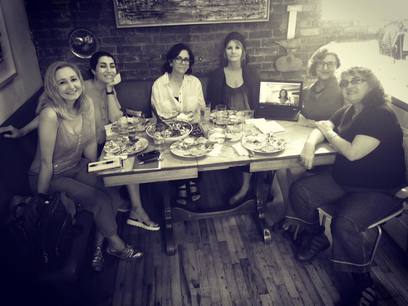
Recently some members of WCA UN Program met at the home of Madeleine Marx-Segall to discuss the project and to offer ideas and support for this program.
From Left:
Natalie Burlutskaya (Re:Artiste)
Hadieh Afshani
Liz DiGiorgio
Maureen Burns-Bowie
Madeleine Marx-Segall
Lea Weinberg
Shirley Siegal (via Skype)
______________________________
|
Clockwise: Kebedech Tekleab, Maureen Burns-Bowie, Liz DiGiorgio, Lea Weinberg, Martha Nicholson, Hadieh Afshani, Natalya Burlutskaya
IT IS DIFFICULT TO GET THE NEWS FROM POEMS, YET MEN DIE MISERABLY EVERY DAY
FOR LACK OF WHAT IS FOUND THERE.
William Carlos Williams
IT IS DIFFICULT TO GET THE NEWS FROM POEMS, YET MEN DIE MISERABLY EVERY DAY
FOR LACK OF WHAT IS FOUND THERE.
William Carlos Williams
__________________________________________
UPDATE #15
REALIZING A CULTURE OF PEACE
Maureen Burns-Bowie
The conference "Realizing a Culture of Peace", was held at the Mohonk Mountain House, an enormous Victorian castle which is now an inn and conference center nestled in the beautiful Shawagunk Mountains of the Hudson Valley. It was founded by Quakers in the 19th century, and has a long , remarkable history. Since it's earliest days it has sponsored meetings and conferences to bring together national and international leaders in an effort to find alternatives to war. They also committed very early on to environmental stewardship. The center initiated the first meetings in what would eventually develop into the World Court, League of Nations and United Nations, and was one of founding members of Nature Conservancy.
Dot Maver was the keynote speaker. She is active with Kosmos Journal, and a founding trustee of National Peace Academy. Other panelists included Ilgu Ozler, a political science professor at SUNY New Paltz, coordinator of youth UN programs, and president of United Nations Association of the Hudson Valley, Iris Spellings, a founder of UN's "Global Movement for a Culture of Peace" and an accomplished artist and photographer, and Fran Tarr, a filmmaker focusing on teens and peace.
The conference took place on November 7, the day before the US presidential election. The air was heavy with trepidation, but it was decided to not discuss the election and to stick to the topic at hand. I can only look back and wonder what the day would have been like if we had met on November 9.
It was acknowledged that currently we are experiencing a total cultural breakdown, but inspiration was drawn from the Chinese symbol of crisis which also includes an image of opportunitiy.
Attention was paid to individual expressions of solidarity, peace, and conservation. We learned of women from Israel and the West Bank who marched together for two weeks to show a desire for peace. And that Bolivia has passed a new law that "earth is a sentient being" and has rights equal to those of a human being. And the United Nations is now debating whether peace is a human right.
Everyone discussed the importance of kindness and tolerance, and the need to connect with people of different viewpoints, rather than trying to convince. We heard stories of hundreds of peace activists who are talking about harmony through conflict. (Conflict is inevitable, violence is not).
The "Iceburgs of Peace and Violence", a concept of Johan Galtung, was an image that guided the discussions. The tip of the iceburg is the manifestations we see in daily life, and the structural issues are submerged and only discovered with reflection and inquiry. The Peace Iceburg was easy to identify -- human/human and human/Earth relations in a spirit of nonviolence and cooperation. The Violence Iceburg was more complicated. The direct physical and verbal violence is easily recognizable. However the underlying structural and cultural violence is less obvious. These unseen factors are the social, economic and political systems that create tension and discord, such as systems of retributive justice and top down globalization. Unseen dangers also include the social norms and values that legitimize and normalize unfair practices, such as fear of hatred of differences, media bias instead of balanced journalism, and a mindset of win/lose self-interest.
A frequent point that came up in many conversations was that we need to build what we want rather than fight what we don't want. Buckminster Fuller advised to build a new model that makes the existing undesirable model obsolete.
On November 16, interestingly enough, the United Nations International Day of Tolerance, Hadieh Afshani and Shirley Siegal presented their first panel discussion in conjunction with the opening of "The First Supper" at MC Gallery in New York City. This is the first exhibition of the installation which will be travelling worldwide. The show is curated by Natalie Burlutskaya.
They describe it:
"The First Supper engages its audience to appreciate the essentiality of compassion and expression, qualities that are deemed to be "femine" but also "fenimist", because they call for women's voices to be heard. Through paintings, art objects, and direct participation of the audience in round table conversations, the art project seeks to engage the audience to lear from andabout one another, ask questions, co-create answers, embrace diversity and practice a peaceful approach to problem solving"
Also joining the panel were Mahboubeh Abbasgholizadeh, an Iranian feminist activist and filmmaker, Florence Nasar, dancer and choreographer, and moderator Zafreen Mahfooz.
The evening was a delightful potpourri of questions asked and ideas generated. Women on the panel discussed the agony of having a strong feeling for their religious backgrounds and culture, yet a rejection of the traditional patriarchy surrounding organized religion. They explored their ideas of a woman's sexuality that should be freely expressed, and the differences between western secular attitudes and more fundamentalist views. There were animated exchanges about the role of art in our lives, and whether or not it really can change the world. And of course, food, which is the nourishment for body and soul, universal, and served lovingly by women.
They describe it:
"The First Supper engages its audience to appreciate the essentiality of compassion and expression, qualities that are deemed to be "femine" but also "fenimist", because they call for women's voices to be heard. Through paintings, art objects, and direct participation of the audience in round table conversations, the art project seeks to engage the audience to lear from andabout one another, ask questions, co-create answers, embrace diversity and practice a peaceful approach to problem solving"
Also joining the panel were Mahboubeh Abbasgholizadeh, an Iranian feminist activist and filmmaker, Florence Nasar, dancer and choreographer, and moderator Zafreen Mahfooz.
The evening was a delightful potpourri of questions asked and ideas generated. Women on the panel discussed the agony of having a strong feeling for their religious backgrounds and culture, yet a rejection of the traditional patriarchy surrounding organized religion. They explored their ideas of a woman's sexuality that should be freely expressed, and the differences between western secular attitudes and more fundamentalist views. There were animated exchanges about the role of art in our lives, and whether or not it really can change the world. And of course, food, which is the nourishment for body and soul, universal, and served lovingly by women.
_____________________________________
UPDATE #17
________________________________________________________
UPDATE #18
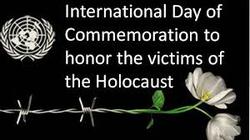
"International Commemoration to Honor Victims of the Holocaust"
Lea Weinberg
As a daughter of Holocaust Survivors, it is important for me to visit the UN Headquarters in New York, NY, for The Holocaust and the United Nations Outreach Program, which “…seeks to remind the world of the lessons to be learned from the Holocaust in order to prevent future acts of genocide.” General Ban Ki-Moon, the UN Secretary, said: “As we remember all those lost during the Holocaust -young and old alike- I call on all nations to protect the most vulnerable, regardless of race, color, gender or religious beliefs.”
On Nov. 1, 2005, the day: January 27 was designated as “the International Holocaust Remembrance Day” that marks the Jan. 1945 liberation of Auschwitz: “…the Holocaust will forever be a warning to all people of the dangers of hatred, bigotry, racism and prejudice” Since 2006, the annual main event of the day, is the United Nations Holocaust Memorial Ceremony, accompanied with Educational activities such as exhibits, NGO meetings, concerts, films screening, lectures and discussions.
The theme for the 2016 Remembrance and activities is: THE HOLOCAUST AND HUMAN DIGNITY “…the right to live free from discrimination and with equal protection under the law that is enshrined in the Universal Declaration of Human Rights. The Holocaust, which resulted in the destruction of nearly two thirds of European Jewry, remains one of the most painful reminders of the international community’s failure to protect them…”
I was on my way to the UN for the private reception- by invitation only, of the exhibit HOLOCAUST BY BULLETS. I was invited after introducing myself on email, explaining how important it is for me to meet the special guest: Father Patrick Desbois- a French Catholic priest who runs the organization “Yahad -In Unum” which means: “Together as One”. I have learned about him on Oct. 2015 from CBS Show 60 Minutes. TV Journalist Lara Logan interviewed him about The Hidden Holocaust… With the help of elderly residents who were children during WWII, Desbois and Yahad have investigated more than 1700 execution sites in the former Soviet Union over the past 10 years. He himself is the grandson of a WWII French prisoner held in the Rawa Ruska camp on the Poland-Ukraine border. His book: The Holocaust by Bullets: A Priest Journey to Uncover the Truth Behind the Murder of 1.5 Million Jews…
I was so impressed by his life mission and his statement: “Genocide is a Disease” meeting him at the reception, I gave him a thankful hug and asked: “ is there a chance the world can cure this horrible disease?” Father Desbois said he believes the immune to this disease is learning from the past starting with school teaching about Tolerance.
The priest is honoring the memory of lost innocent victims by making the world open its eyes, through finding a lot of people that remember what had happened when they were very young. The Ukraine children have seen the murders but couldn’t do anything to stop it, or even maybe they didn’t understand (as a matter of fact, who can understand this evil act...) Seeing such horrible images as children is unforgettable and now, while those ‘children’ are more than 70 years old, they are willing to tell what they remember…
The large photographs in the exhibit presenting the results of hundreds of days of fieldwork that enabled the organization “Yahad-In Unum” to collect evidence of massacres during the WWII in order to return memory and dignity to Jewish victims. It also underscores the "Holocaust by Bullets" as a precursor and model for mass crimes today. The Exhibit was organized by Permanent Mission of France to the United Nations organizes the exhibit.
On the International Day of Commemoration in memory of the victims of the Holocaust, I was on my way again to NYC for the UN Holocaust Memorial Ceremony. During the train ride from White Plains, NY to Grand Central station, NY my thoughts were leading me to another train ride, 72 years earlier: on May 1944, my mother with her parents, her 2 brothers and 2 sisters were altogether, for the last time as the GELB Family of 7, on a car train from Czechoslovakia leading to Auschwitz… my Mother Paula was the only survivor…
Every year while arriving at the UN building, I have the same mesmerizing feeling seeing the very long line of people from all over the world, all religious, colors and genders, young people as well as very old, so many people who put aside their activities at home /work /school and are waiting patiently to go through the security process, before entering the General Assembly Hall for 2 hours (11am to 1pm) of listening to various talks about a difficult chapter in history, 2 hours of paying respect to survivors and to the memory of innocent victims; so many non Jewish in the audience, are interested to be part of the remembrance, so many people care and understand that one needs to be learning from the past if one wish to build a better future.
Ms. Cristina Gallach, Under-Secretary-General for Communications and Public Information, hosted the event. The ceremony included remarks by United Nations Secretary-General Ban Ki-moon; H. E. Mr. Mogens Lykketoft, President of the seventieth session of the General Assembly; H.E. Mr. Danny Danon, Permanent Representative of Israel to the United Nations; H.E. Ms. Samantha Power, Permanent Representative of the United States to the United Nations and H.E. Mr. Felix Klein, Special Representative for relations with Jewish Organizations, issues relating to Anti-Semitism and Holocaust Remembrance. In addition, Mr. Szabolcs Takács, the Chair of the Holocaust Remembrance Alliance made a statement. Ms. Barbara Winton opened a video tribute to her father, Sir Nicholas Winton, who rescued 669 children from the Holocaust on the Czech Kindertransport. Mrs. Beate Klarsfeld (Germany) was a keynote speaker.
All the talks were incredibly interesting, emotional and very important I would like to quote a few words from the personal testimony that was delivered by 3 Holocaust survivors:
-Mrs. Marta Wise, a Jewish Holocaust survivor, born in Czechoslovakia who was a 10 years old in Auschwitz: ”… World anti-Semitism is even more evident today with the threats of economic and academic boycotts on Israel... a reminder of the steps taken by Nazi Germany with the rise of Hitler. Then, as now, the world is standing by silently. People often ask where was G-d during the holocaust. My question is where was man?”…
-Mr. Haim Roet, a Jewish Holocaust survivor, born in Amsterdam in 1932, is the father of Ambassador David Roet, Israel’s Deputy Permanent Representative to the United Nations, told the Audience that what strengthen him were the memories of his parents, his brothers and sisters and the memories of the holidays: “...looking back 70 years, it is heart-breaking that as a world we did not learn enough from the Holocaust. Genocides are still going on, and 11 year old kids like I was, are still killed and suffering in too many places. Genocides must be stopped and prevented everywhere. There are less and less survivors that can tell their stories. These stories must continue to be told so we can remember the victims and the communities that disappeared. But it is even more important that the lessons of the Holocaust serve as a warning of where blind hate and racism lead to.”
-Mr. Zoni Weisz, a Sinto survivor told us he still remembers every detail of the train: “…everything needs to be SHNELL…” (I felt as my mother was telling me her same experience) He said: “…Even after more than 70 years, these horrible experiences are still very much alive. We survivors have the task to speak about it as a warning against upcoming racism and discrimination. Rising anti-Semitism and -Gypsyism is the order of the day in many European countries. Jews, Roma and Sinti are harassed and assaulted. A civilized society respects human rights. We have the task to keep the memory of our loved ones alive. Auschwitz Never Again.” Mr. Zoni couldn’t stop his cry, saying: “Despite of the loss…I have become a happy person” like many other survivors who built a new family, alongside the memory of those who perished. I believe that many from the audience’s eyes were wet as my eyes.
Cantor Gideon Zelermyer, accompined by Shaar Hashomayim Synagogue Choir from Montreal, Canada, recited the memorial prayers/ Roma musicians Antal Kopar(guitar) and Bela Horvath (violin) performed during the ceremony/ the event was concluded with a performance by the United States Military Academy Jewish Chapel Choir, West Point. It was a Heartfelt Event !
I also joined a morning conference: “The Future of Holocaust Education” The United Nations Department of Public Information NGO Briefing, brought together experts from academic institutions and international organizations, researchers, educators and authors who examined current trends in Holocaust research and education. Key questions discussed: how to expand teacher training and Holocaust education around the world; how to adapt to a changing environment with the rise of multicultural classroom settings and fewer and fewer eye witnesses to testify to the Holocaust and what role international organizations have to play in the field..
The panelists were:
-Szabolcs Takács, Chair of IHRA, International Holocaust Remembrance Alliance; -Debórah Dwork, Rose Professor of Holocaust History and Director, Strassler Center for Holocaust and Genocide Studies, Clark University;
-Professor Zehavit Gross, Chairholder, UNESCO/Burg Chair in Education for Human Values, Tolerance and Peace, Bar-llan University, Israel------Cecilie Felicia Stokholm Banke, Senior Researcher, Danish Institute for International Studies
-Jane Jacobs-Kimmelman, Director of the International Relations Department at the International School for Holocaust Studies at Yad Vashem. -----The discussion was moderated by Kimberly Mann, the Chief of Education Outreach Section in Outreach Division of UN Department of Public Information
It is so important for me to be present at such events, discussions and conferences, I am glad to discover each time how many humans are looking for a better future and are willing to work for it, to try and discover ways and solution, the talks are not only about Jews, not only about the holocaust the same as the audience which includes other nationalities, and other genocides, the opportunity of getting in Togetherness, aiming for good with Hope for Humanity
I will try to recall a few remarks from that day:
All Human beings are born free
The Holocaust - a breakdown of Humanity
Everyone has a huge responsibility
Under every victim there is a name, a story
Freedom is nothing but the chance to be Better
Respect for people regardless
Nothing can be compared to the Holocaust, yet there are so many other genocides
Best way to reach people is through education
My part in holocaust education is through contemporary art. As a second generation of holocaust survivors and as an artist, I feel obligated to present a visual message preserving the stories I have personally heard. My mother’s personal story is intertwined with the Shoah history in my ongoing project: MOTHER-SURVIVOR- a 6 series sculptural installation; I chose the use of humble materials using my main sculpting medium, the wire mesh, along with rusty metal, used hangers, photographs and found objects to express the beauty of imperfection and the idea that everyone can contribute to life. The artwork is highly symbolic, inspired by my optimistic mother and her story of finding 8 family photographs of her family, while working as a clothes -sorter in Auschwitz-Birkenau, and hiding the 8 photos inside bread until liberation day. I invite high school students to interact with my exhibit-installation and their reaction and the letters they sent me afterwards, shows me it is a good way to educate the future generation.
Below: Images from exhibition
Lea with Father Desbois
Lea Weinberg
As a daughter of Holocaust Survivors, it is important for me to visit the UN Headquarters in New York, NY, for The Holocaust and the United Nations Outreach Program, which “…seeks to remind the world of the lessons to be learned from the Holocaust in order to prevent future acts of genocide.” General Ban Ki-Moon, the UN Secretary, said: “As we remember all those lost during the Holocaust -young and old alike- I call on all nations to protect the most vulnerable, regardless of race, color, gender or religious beliefs.”
On Nov. 1, 2005, the day: January 27 was designated as “the International Holocaust Remembrance Day” that marks the Jan. 1945 liberation of Auschwitz: “…the Holocaust will forever be a warning to all people of the dangers of hatred, bigotry, racism and prejudice” Since 2006, the annual main event of the day, is the United Nations Holocaust Memorial Ceremony, accompanied with Educational activities such as exhibits, NGO meetings, concerts, films screening, lectures and discussions.
The theme for the 2016 Remembrance and activities is: THE HOLOCAUST AND HUMAN DIGNITY “…the right to live free from discrimination and with equal protection under the law that is enshrined in the Universal Declaration of Human Rights. The Holocaust, which resulted in the destruction of nearly two thirds of European Jewry, remains one of the most painful reminders of the international community’s failure to protect them…”
I was on my way to the UN for the private reception- by invitation only, of the exhibit HOLOCAUST BY BULLETS. I was invited after introducing myself on email, explaining how important it is for me to meet the special guest: Father Patrick Desbois- a French Catholic priest who runs the organization “Yahad -In Unum” which means: “Together as One”. I have learned about him on Oct. 2015 from CBS Show 60 Minutes. TV Journalist Lara Logan interviewed him about The Hidden Holocaust… With the help of elderly residents who were children during WWII, Desbois and Yahad have investigated more than 1700 execution sites in the former Soviet Union over the past 10 years. He himself is the grandson of a WWII French prisoner held in the Rawa Ruska camp on the Poland-Ukraine border. His book: The Holocaust by Bullets: A Priest Journey to Uncover the Truth Behind the Murder of 1.5 Million Jews…
I was so impressed by his life mission and his statement: “Genocide is a Disease” meeting him at the reception, I gave him a thankful hug and asked: “ is there a chance the world can cure this horrible disease?” Father Desbois said he believes the immune to this disease is learning from the past starting with school teaching about Tolerance.
The priest is honoring the memory of lost innocent victims by making the world open its eyes, through finding a lot of people that remember what had happened when they were very young. The Ukraine children have seen the murders but couldn’t do anything to stop it, or even maybe they didn’t understand (as a matter of fact, who can understand this evil act...) Seeing such horrible images as children is unforgettable and now, while those ‘children’ are more than 70 years old, they are willing to tell what they remember…
The large photographs in the exhibit presenting the results of hundreds of days of fieldwork that enabled the organization “Yahad-In Unum” to collect evidence of massacres during the WWII in order to return memory and dignity to Jewish victims. It also underscores the "Holocaust by Bullets" as a precursor and model for mass crimes today. The Exhibit was organized by Permanent Mission of France to the United Nations organizes the exhibit.
On the International Day of Commemoration in memory of the victims of the Holocaust, I was on my way again to NYC for the UN Holocaust Memorial Ceremony. During the train ride from White Plains, NY to Grand Central station, NY my thoughts were leading me to another train ride, 72 years earlier: on May 1944, my mother with her parents, her 2 brothers and 2 sisters were altogether, for the last time as the GELB Family of 7, on a car train from Czechoslovakia leading to Auschwitz… my Mother Paula was the only survivor…
Every year while arriving at the UN building, I have the same mesmerizing feeling seeing the very long line of people from all over the world, all religious, colors and genders, young people as well as very old, so many people who put aside their activities at home /work /school and are waiting patiently to go through the security process, before entering the General Assembly Hall for 2 hours (11am to 1pm) of listening to various talks about a difficult chapter in history, 2 hours of paying respect to survivors and to the memory of innocent victims; so many non Jewish in the audience, are interested to be part of the remembrance, so many people care and understand that one needs to be learning from the past if one wish to build a better future.
Ms. Cristina Gallach, Under-Secretary-General for Communications and Public Information, hosted the event. The ceremony included remarks by United Nations Secretary-General Ban Ki-moon; H. E. Mr. Mogens Lykketoft, President of the seventieth session of the General Assembly; H.E. Mr. Danny Danon, Permanent Representative of Israel to the United Nations; H.E. Ms. Samantha Power, Permanent Representative of the United States to the United Nations and H.E. Mr. Felix Klein, Special Representative for relations with Jewish Organizations, issues relating to Anti-Semitism and Holocaust Remembrance. In addition, Mr. Szabolcs Takács, the Chair of the Holocaust Remembrance Alliance made a statement. Ms. Barbara Winton opened a video tribute to her father, Sir Nicholas Winton, who rescued 669 children from the Holocaust on the Czech Kindertransport. Mrs. Beate Klarsfeld (Germany) was a keynote speaker.
All the talks were incredibly interesting, emotional and very important I would like to quote a few words from the personal testimony that was delivered by 3 Holocaust survivors:
-Mrs. Marta Wise, a Jewish Holocaust survivor, born in Czechoslovakia who was a 10 years old in Auschwitz: ”… World anti-Semitism is even more evident today with the threats of economic and academic boycotts on Israel... a reminder of the steps taken by Nazi Germany with the rise of Hitler. Then, as now, the world is standing by silently. People often ask where was G-d during the holocaust. My question is where was man?”…
-Mr. Haim Roet, a Jewish Holocaust survivor, born in Amsterdam in 1932, is the father of Ambassador David Roet, Israel’s Deputy Permanent Representative to the United Nations, told the Audience that what strengthen him were the memories of his parents, his brothers and sisters and the memories of the holidays: “...looking back 70 years, it is heart-breaking that as a world we did not learn enough from the Holocaust. Genocides are still going on, and 11 year old kids like I was, are still killed and suffering in too many places. Genocides must be stopped and prevented everywhere. There are less and less survivors that can tell their stories. These stories must continue to be told so we can remember the victims and the communities that disappeared. But it is even more important that the lessons of the Holocaust serve as a warning of where blind hate and racism lead to.”
-Mr. Zoni Weisz, a Sinto survivor told us he still remembers every detail of the train: “…everything needs to be SHNELL…” (I felt as my mother was telling me her same experience) He said: “…Even after more than 70 years, these horrible experiences are still very much alive. We survivors have the task to speak about it as a warning against upcoming racism and discrimination. Rising anti-Semitism and -Gypsyism is the order of the day in many European countries. Jews, Roma and Sinti are harassed and assaulted. A civilized society respects human rights. We have the task to keep the memory of our loved ones alive. Auschwitz Never Again.” Mr. Zoni couldn’t stop his cry, saying: “Despite of the loss…I have become a happy person” like many other survivors who built a new family, alongside the memory of those who perished. I believe that many from the audience’s eyes were wet as my eyes.
Cantor Gideon Zelermyer, accompined by Shaar Hashomayim Synagogue Choir from Montreal, Canada, recited the memorial prayers/ Roma musicians Antal Kopar(guitar) and Bela Horvath (violin) performed during the ceremony/ the event was concluded with a performance by the United States Military Academy Jewish Chapel Choir, West Point. It was a Heartfelt Event !
I also joined a morning conference: “The Future of Holocaust Education” The United Nations Department of Public Information NGO Briefing, brought together experts from academic institutions and international organizations, researchers, educators and authors who examined current trends in Holocaust research and education. Key questions discussed: how to expand teacher training and Holocaust education around the world; how to adapt to a changing environment with the rise of multicultural classroom settings and fewer and fewer eye witnesses to testify to the Holocaust and what role international organizations have to play in the field..
The panelists were:
-Szabolcs Takács, Chair of IHRA, International Holocaust Remembrance Alliance; -Debórah Dwork, Rose Professor of Holocaust History and Director, Strassler Center for Holocaust and Genocide Studies, Clark University;
-Professor Zehavit Gross, Chairholder, UNESCO/Burg Chair in Education for Human Values, Tolerance and Peace, Bar-llan University, Israel------Cecilie Felicia Stokholm Banke, Senior Researcher, Danish Institute for International Studies
-Jane Jacobs-Kimmelman, Director of the International Relations Department at the International School for Holocaust Studies at Yad Vashem. -----The discussion was moderated by Kimberly Mann, the Chief of Education Outreach Section in Outreach Division of UN Department of Public Information
It is so important for me to be present at such events, discussions and conferences, I am glad to discover each time how many humans are looking for a better future and are willing to work for it, to try and discover ways and solution, the talks are not only about Jews, not only about the holocaust the same as the audience which includes other nationalities, and other genocides, the opportunity of getting in Togetherness, aiming for good with Hope for Humanity
I will try to recall a few remarks from that day:
All Human beings are born free
The Holocaust - a breakdown of Humanity
Everyone has a huge responsibility
Under every victim there is a name, a story
Freedom is nothing but the chance to be Better
Respect for people regardless
Nothing can be compared to the Holocaust, yet there are so many other genocides
Best way to reach people is through education
My part in holocaust education is through contemporary art. As a second generation of holocaust survivors and as an artist, I feel obligated to present a visual message preserving the stories I have personally heard. My mother’s personal story is intertwined with the Shoah history in my ongoing project: MOTHER-SURVIVOR- a 6 series sculptural installation; I chose the use of humble materials using my main sculpting medium, the wire mesh, along with rusty metal, used hangers, photographs and found objects to express the beauty of imperfection and the idea that everyone can contribute to life. The artwork is highly symbolic, inspired by my optimistic mother and her story of finding 8 family photographs of her family, while working as a clothes -sorter in Auschwitz-Birkenau, and hiding the 8 photos inside bread until liberation day. I invite high school students to interact with my exhibit-installation and their reaction and the letters they sent me afterwards, shows me it is a good way to educate the future generation.
Below: Images from exhibition
Lea with Father Desbois
____________________________________________________________________________
UPDATE # 19
December 10
UNITED NATIONS Human Rights Day
Message from the Director:
|
____________________________________________________________________________
UPDATE #20
New Leadership
Maureen Burns-Bowie
The term of Secretary General Ban Ki Moon is over. Following in his footsteps is Antonio Guterres, who is the former Prime Minister of Portugal. He was a leftist leader who was respected for fairness, depth, and honesty. He said he ruled with heart and reason. He was known to anonymously go to slums and tutor children in math. Later, as United Nations High Commissioner for Refugees, he expanded the definition of refugees to include all displaced persons. The priority for his administration as Secretary General is peace.
PASS BLUE reported: "He was chosen by the permanent members of the UN Security Council - Britain, China, France, Russia, and the US - based on his skills as a negotiator, his serene bearing, his articulate, practical way of relating to people and his refugee roots at the UN - but also because he pledged transparency."
Maureen Burns-Bowie
The term of Secretary General Ban Ki Moon is over. Following in his footsteps is Antonio Guterres, who is the former Prime Minister of Portugal. He was a leftist leader who was respected for fairness, depth, and honesty. He said he ruled with heart and reason. He was known to anonymously go to slums and tutor children in math. Later, as United Nations High Commissioner for Refugees, he expanded the definition of refugees to include all displaced persons. The priority for his administration as Secretary General is peace.
PASS BLUE reported: "He was chosen by the permanent members of the UN Security Council - Britain, China, France, Russia, and the US - based on his skills as a negotiator, his serene bearing, his articulate, practical way of relating to people and his refugee roots at the UN - but also because he pledged transparency."
